- Grasses vs. Sedges
- Guide to Plant Descriptions
- Botanical Terms Used to Describe Grass and Sedge Plants
- Definitions of Terms Shown in the Figures
- Warm-season Grasses
- Cool-season Grasses
- Sedges
- Glossary
- References
- Guide to Selecting Native Grasses and Sedges
- Acknowledgments
“Grasses are the hair of Mother Earth”
— Karl Foerster
Few plants on Earth are more versatile or have a greater impact on the environment than grasses. They are major contributors to the total net photosynthesis and production of biomass in the world. They tame the erosive splash of raindrops, stabilize soil and assist the infiltration of water into the ground and aquifers. They interact ecologically with a diverse number of flora and fauna, both above and below ground, including insects, fungi, birds and mammals. Many insects, for example, rely on native grasses as a substrate on which they lay their eggs or as a larval food source in order to complete their life cycles. These same insects, in turn, are eaten by birds and mammals higher up the food chain. Many species of mammals, birds and insects also rely on grasses for shelter and nesting materials.
No other plant has played a more vital role in the development of civilization than grasses. For thousands of years, wild grasses have been cultivated and domesticated for human consumption and as feedstock for livestock and herds of wild animals. Most of the cultivated grains we use today, including wheat, barley, rye, oats, corn, rice, millet and sorghum, were developed from wild native grasses. Over the years, plant breeders and agronomists have made dramatic improvements in grain yields. One of the most notable was Norman Borlaug, an Iowa-born scientist and winner of the 1970 Nobel Peace Prize. He developed a high-yielding disease-resistant wheat that helped feed the world and saved millions of people in impoverished nations from starvation.
The grass family, Poaceae, is the fourth-largest plant family on Earth, with more than 10,000 species. Globally, grasses grow in all terrestrial habitats, including forests, glades, savannas, open deserts, prairies, wetlands, stream banks and floodplains. Yet grasses are relatively young plants in terms of their evolutionary history. The earliest evidence of fossilized grass pollen was found in South America and dates to the Paleocene Epoch, 55 to 65 million years ago. To put this in perspective, dinosaurs never ate grasses because grasses evolved after dinosaurs were extinct.
The southeastern United States is home to about 1,400 native grass species. Many of these species are managed for erosion control or wildlife habitats. Others have been domesticated as pasture grasses and other types of animal forage, such as grain or baled hay. A few species, such as Muhly Grass, Switchgrass and River Oats, have become popular in the landscape trade.
This publication describes and illustrates 48 grasses and 10 sedges native to Georgia. It is not the intent of the authors to describe all native grasses and sedges, but those that are most widespread or those having practical application for wildlife habitats, erosion control, restoration projects or landscape culture. A few of the plants are noted as being weedy or invasive and may not be appropriate for use in cultivated landscapes. Nonetheless, they are included to assist the reader in identifying them because they are abundant in the wild.
This publication further separates grasses into two categories: warm-season grasses and cool-season grasses. Warm-season grasses begin growing when daily temperatures are between 60 °F and 65 °F. They grow in the summer, flower and fruit in the fall, and then go dormant after the first frost. Examples are Broomsedge, Bluestems and Indian Grasses. Cool-season grasses grow in the late fall, winter and early spring, flower and fruit in the late spring, then go dormant in the summer. Examples include Oatgrasses, Witchgrasses and Bluegrasses.
Grasses vs. Sedges
Grasses and sedges belong to two different plant families. They are sometimes difficult to tell apart, but they can be distinguished from one another by differences in their structures, habitats or life cycles.
- Grass stems are typically round or flat and hollow inside, while those of sedges are triangular and solid inside.
- Grasses have swollen nodes or joints along their stems, while sedges do not.
- Grasses produce both vegetative and floral stems, while sedges produce only floral stems.
- The leaves of grasses are usually two-ranked, which means they occur in two rows on opposite sides of the stems, while the leaves of sedges are three-ranked and occur in three vertical planes along the stems.
- The flowers of many grasses are showy, but those of many sedges tend to be inconspicuous.
- Grasses are most abundant in dry, open habitats, while sedges prefer moist to wet areas.
- Grasses can be either annuals or perennials, but sedges are primarily perennials.
Establishing and Managing a Native Grass Meadow
Whether one is interested in the ecological management of an existing native grassland, converting an old pasture to a more diverse mixture of forbs (broadleaf herbaceous plants) and native grasses, establishing native grasses under utility easements or incorporating native grasses into a cultivated landscape, a great deal of planning is required to do the job properly. Creating a native grass meadow is a lot different from planting a mono-culture lawn with just one type of grass. Natural grass communities are diverse ecosystems with many different grasses growing in harmony with a variety of forbs. Grasses typically occupy between 65 percent and 70 percent of the total space.
Listed below are some suggested guidelines for planning, establishing and managing a native grass meadow. Each one has many alternatives and options.
Analyze the site
- Identify and make a list of ALL of the existing plants on the site, including native plants, exotic plants and weeds, as well as cool-season and warm-season annuals or perennials.
- Determine the sunlight exposure throughout the day.
- Note the topography and drainage of the site, including slopes, elevated areas that might stay drier than surrounding areas, and low spots where water can collect after rain.
- Determine the size of the area to be planted. There are 43,560 square feet in 1 acre.
- Take a sample of the soil and have it tested through the state soil testing laboratory. There is a nominal fee for this service (for information on soil sampling and testing, see https://aesl.ces.uga.edu/soil.html). A soil test provides recommendations for lime and fertilizer prior to planting. However, while lime may be required to achieve the proper pH in the soil for optimum plant growth, fertilizer is not recommended for native grass meadows because it will encourage weeds that compete with grasses.
- Make note of any existing plants that have to be eliminated before the meadow can be established. If the site is overgrown with invasive plants, brush or scrub trees, it may be a candidate for restoration instead of rehabilitation. On the other hand, if the site contains a significant number of native plants, then adding a few native grasses to increase the diversity of the site may be all that is needed.
- Right-of-ways under power lines will require frequent monitoring during establishment because birds roosting on the lines and mammals grazing on plants in the open field may introduce unwanted weed seeds.
- Observe plant communities adjacent to the planting site and the potential for wind, water or wildlife to transport seeds from those communities into the grass meadow.
Determine your budget and equipment needs
- Determine early in the planning process how much money the project costs and how much time and energy must be devoted to the project, not only for the initial installation, but also for follow-up management.
- Determine the types of plants or seeds needed and their costs. Some grasses can be established from seeds, while others can be established from plugs (small well-rooted plants grown from seed). Consider the cost of each of these alternatives. Seeds or plugs will need to be ordered in advance. Some native grasses simply are not available in the trade, so seeds or plants must be harvested from the wild. Often this requires the assistance of a knowledgeable botanist to identify plants and to determine the best time to harvest seeds or plants. Sometimes the Georgia Native Plant Society (www.gnps.org) or the Georgia Botanical Society (www.gabotsoc.org) sponsor field trips for persons interested in collecting native plants or seeds. It is illegal to harvest seeds or plants from private property without first obtaining permission from the landowner, and the collection of plants or seeds from land owned by federal or state agencies is prohibited. Most native grasses available from nurseries are propagated from seed.
- A mower will be required during establishment to prevent annual weeds from competing with and shading out the new plants. A mower that can be adjusted to a cutting height of 5 to 6 inches is ideal.
- A sprayer for applying herbicides will be needed to eliminate unwanted vegetation prior to planting or to target specific weeds during establishment.
- Large restoration sites may require cultivation at two-week intervals prior to planting to eliminate unwanted vegetation. A contractor may be required for these large tasks, which will add to the cost.
Plan for a diverse plant community that matches the site conditions
- The typical Southeastern grass meadow is a mixture of both cool-season grasses and warm-season grasses, a few sedges and a variety of forbs, like legumes, sunflowers, mints, goldenrods and milkweeds. Make certain the newly introduced plants require the same sunlight exposure, soil type and drainage as that of the existing native vegetation.
- Including a variety of forbs along with grasses will create a more natural balanced environment. However, make certain the mature heights of the forbs added to the mix do not exceed those of the grasses. Otherwise, shading can occur, and the grasses will struggle to get established.
- Where weeds are a problem, a mixture of grasses and forbs that are taller or more aggressive than the weeds may be needed.
Options when preparing the site
- If any type of soil disturbance is done, expect weed seed germination. Regular cultivation for one or two growing seasons prior to planting may be necessary to reduce weed competition. A combination of disking and shallow cultivation can be effective. Disking places some weed seeds too deeply in the soil to germinate. Light cultivation six to eight weeks after disking will kill any newly geminated weeds on the soil surface. Repeat these steps as necessary.
- Sites dominated by weeds may require an aggressive approach using a combination of cultivation to encourage weed seed germination and herbicide applications to kill the newly germinated weeds. Repeated herbicide applications will gradually deplete the weed seed bank in the soil and reduce successive weed populations.
- In some areas, controlled burning to eliminate existing vegetation is allowed. Check with your local office of the Georgia Forestry Commission to determine whether controlled burning is allowed in your area and the requirements for doing it.
- Heat sterilization (solarization) is another option for small areas. This involves placing sheets of clear plastic over the unwanted vegetation and sealing it along the edges with soil or rocks. The elevated temperatures under the plastic will kill herbaceous weeds, but it may not eliminate established woody vegetation. This technique works best during the warm summer months.
Planting
- When purchasing seeds or plants, make certain they are adapted to your geographical region. Plants produced from seed harvested from native grasses growing in the western prairies or desert regions of the U.S. may not be well adapted to the Southeast, even if the species is recommended for the area. Botanists and horticulturists often refer to “ecotypes” that are subspecies or varieties adapted to a particular set of environmental conditions. A plant's place of origin or “provenance” is known to influence the adaptability of its offspring to a particular set of environmental conditions.
- Warm-season grasses are best planted from April to June, while cool-season grasses do best when planted from September to October.
- On sites prone to erosion, a cover crop, such as winter wheat (an annual), may need to be planted along with the grasses and forbs to help stabilize the soil during establishment.
- Plant forbs in colonies of several plants between the grasses. Clusters of forbs will not only be more visible, but also will do a better job of attracting pollinators.
- Seeds need to be in contact with the soil for best germination. When planting plugs, place the crown (the area between the base of grass blades and the roots) slightly below ground level.
- Native grasses grow well in soils having low fertility. Avoid fertilizing after planting because it will encourage weed competition.
- Supplemental irrigation may be necessary during periods of limited rainfall for at least three to six weeks while the seeds are germinating and the plants are establishing.
Management
Managing a grass meadow requires annual observations as to how the plants are moving around, re-seeding and spreading. Also observe the balance of grasses to forbs and make note of unwanted weeds. A grass meadow is an ever-changing panorama as the balance of grasses to forbs is influenced by changing weather patterns and new plants introduced by passing wildlife or wind. Unlike a highly manicured cultivated landscape that is carefully managed and manipulated by mowing, pruning and fertilization, Mother Nature manages a native grass meadow.
- One of the greatest challenges is to distinguish the good weeds from the bad weeds. Some weeds are tame and offer little competition for the grasses and forbs. Others are considered “thugs” that spread rapidly from rhizomes or seeds and are hard to control. Examples are Burdock, Yellow Star Thistle (annual), Canada Thistle, Bermudagrass, Nutgrass, Crab Grass (annual), Crown Vetch, Canada Goldenrod, Johnsongrass and Chinese Lespedeza.
- In natural environments, grass meadows are managed by grazing from wildlife or livestock, or they are burned back by wildfires or controlled burns. Occasional mowing to a height of 5 to 6 inches can substitute for grazing. Mowing from late May through June will scatter seeds and rejuvenate cool-season grasses, then mowing again in late winter will scatter seeds and rejuvenate warm-season grasses. To encourage forbs to seed in and multiply, rake off the residue after mowing. Raking scatters the seeds of forbs, helps seed-to-soil contact and allows light to reach the new plants. Otherwise, if the planting is well-balanced with grasses and forbs, leave the mowing residue in place to act as natural mulch.
- Controlled burning is an alternative to mowing in areas where outdoor burning is allowed. Check with your local division of the Georgia Forestry Commission for laws and regulations regarding controlled burns. Annual burning once the grass meadow is fully established (three to five years after planting) will rejuvenate the planting.
Guide to Plant Descriptions
Native grasses and sedges described in this publication are listed alphabetically according to their botanical name. Grasses are divided into two categories: warm-season grasses and cool-season grasses. The appendix contains a Guide for Selecting Native Grasses and Sedges according to their growing requirements and usages. Information on each plant is provided according to the following criteria:
Common Name(s) / Botanical Name
Life Cycle
Characteristics
Cultural Requirements
Time of Bloom
Suggested Uses
Georgia Hardiness Zones
Size
Habitat
Native To
Propagation
Comments
Common Name(s) / Botanical Name: Many of the plants have more than one common name. Those that are most often used are listed. For this publication, Flora of Southern and Mid-Atlantic States by Alan S. Weakley, North Carolina Herbarium, was used as the definitive source for botanical names. Plants that were re-classified into a new genus also show the previous botanical name in the form of a synonym (syn.) after the current name.
Life Cycle: Native grasses may be annuals or perennials, while sedges are perennials. Annuals flower, fruit and die in one growing season. Perennials flower and fruit each year, and they live for several years.
Characteristics: This section provides a botanical description of the plant that will assist the reader in identifying it. Noteworthy characteristics such as growth habit, leaf arrangement or shape, flower type and color, and seed structure are provided.
Cultural Requirements: A description of the type of growing environment the plant needs to thrive, such as the light level, soil type and soil conditions, is provided. Other information useful in managing the plant, such as pruning to remove old foliage prior to new growth or pruning before seed set to prevent seed dispersal, is included where appropriate.
Time of Bloom: The months of the year when the plant typically flowers in Georgia.
Suggested Uses: Some grasses are used for controlling erosion or restoring disturbed sites. Others are used in wildlife habitats. Still others may have ornamental value and are used in cultivated landscapes. The growing requirements and native habitat of the plant are considered when providing suggested uses.
Georgia Hardiness Zones: The Cold Hardiness Zones in Georgia to which the plant is adapted are shown here. These zones are based on the 2012 U.S. Department of Agriculture Hardiness Zone Map for the United States. Figure 2 shows the 2012 Cold Hardiness Zones for Georgia.
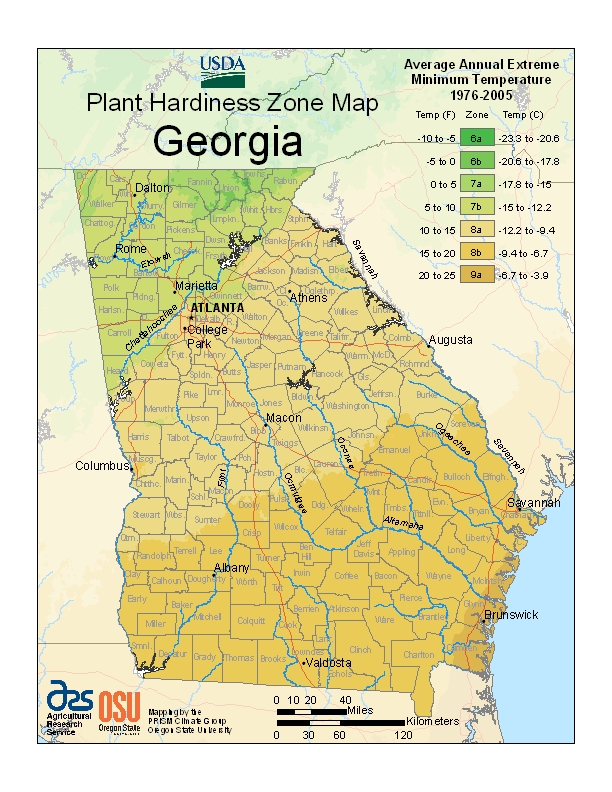 Cold Hardiness Zones in Georgia (Credit: U.S. Department of Agriculture, 2012).
Cold Hardiness Zones in Georgia (Credit: U.S. Department of Agriculture, 2012).
Size: The expected mature height and/or spread of the plant under ideal cultural conditions.
Habitat: The environment(s) in which the plant is found in the wild.
Native To: A general description of the region within the continental U.S. where the plant is presently found in its native habitat.
Comments: Additional information about the plant that the reader may find interesting.
Botanical Terms Used to Describe Grass and Sedge Plants
Terminology used to describe the parts of grasses and sedges differs from that of herbaceous or woody plants. The illustrations in figures 1, 2 and 3 show terms commonly used to describe the parts of grasses and sedges, followed by definitions of the terms used in the figures. A glossary at the end of this publication provides the reader with additional definitions of terms used elsewhere in this publication.
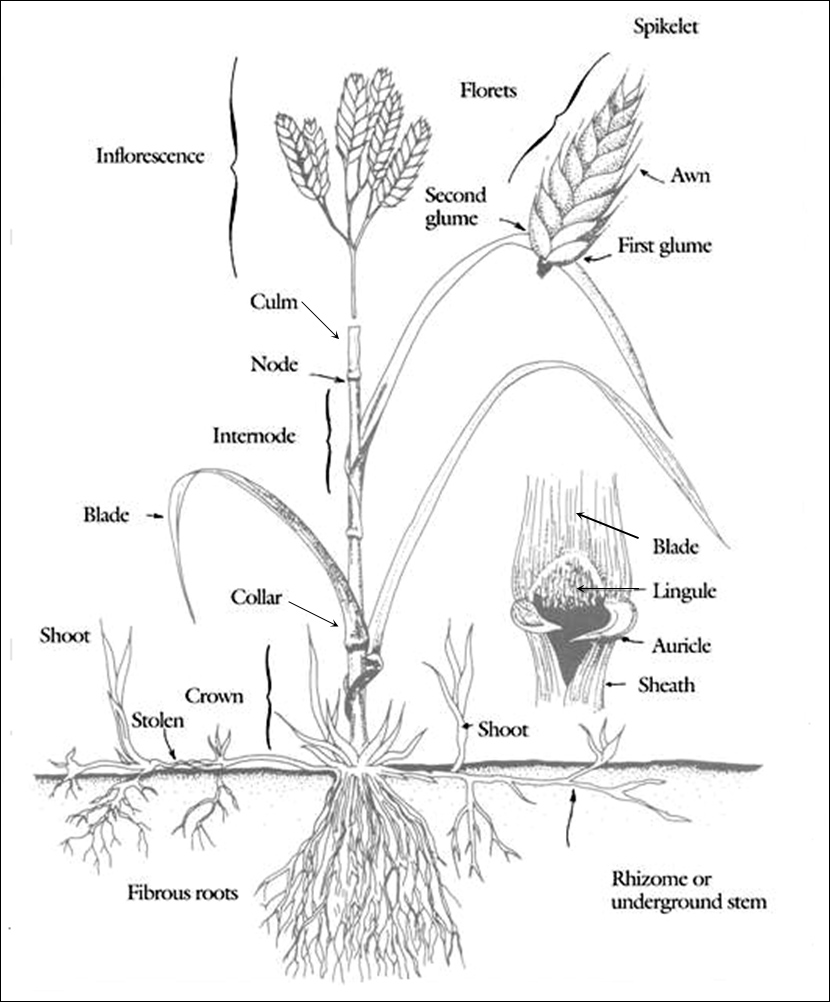 Figure 1. Parts of Grass and Sedge Plants (Credit: National Drought Mitigation Center, Lincoln, Neb.).
Figure 1. Parts of Grass and Sedge Plants (Credit: National Drought Mitigation Center, Lincoln, Neb.).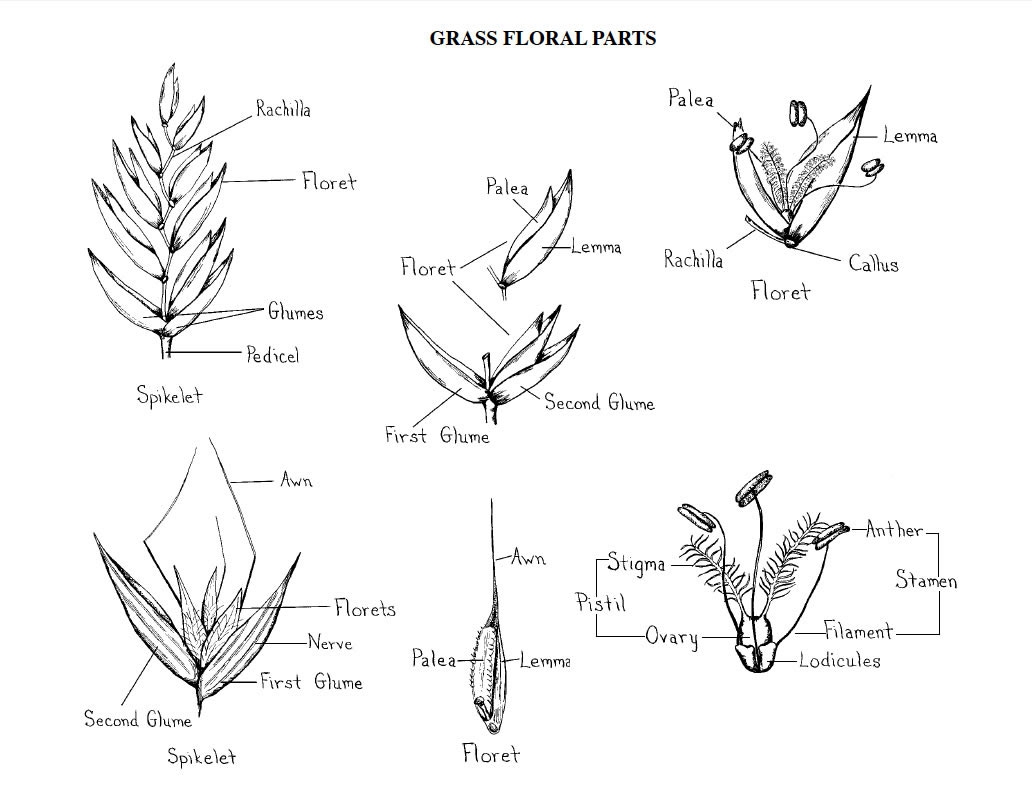 Figure 2. Grass Floral Parts (Credit: Norman Melvin, USDA Cold Region Research and Engineering Laboratory).
Figure 2. Grass Floral Parts (Credit: Norman Melvin, USDA Cold Region Research and Engineering Laboratory).
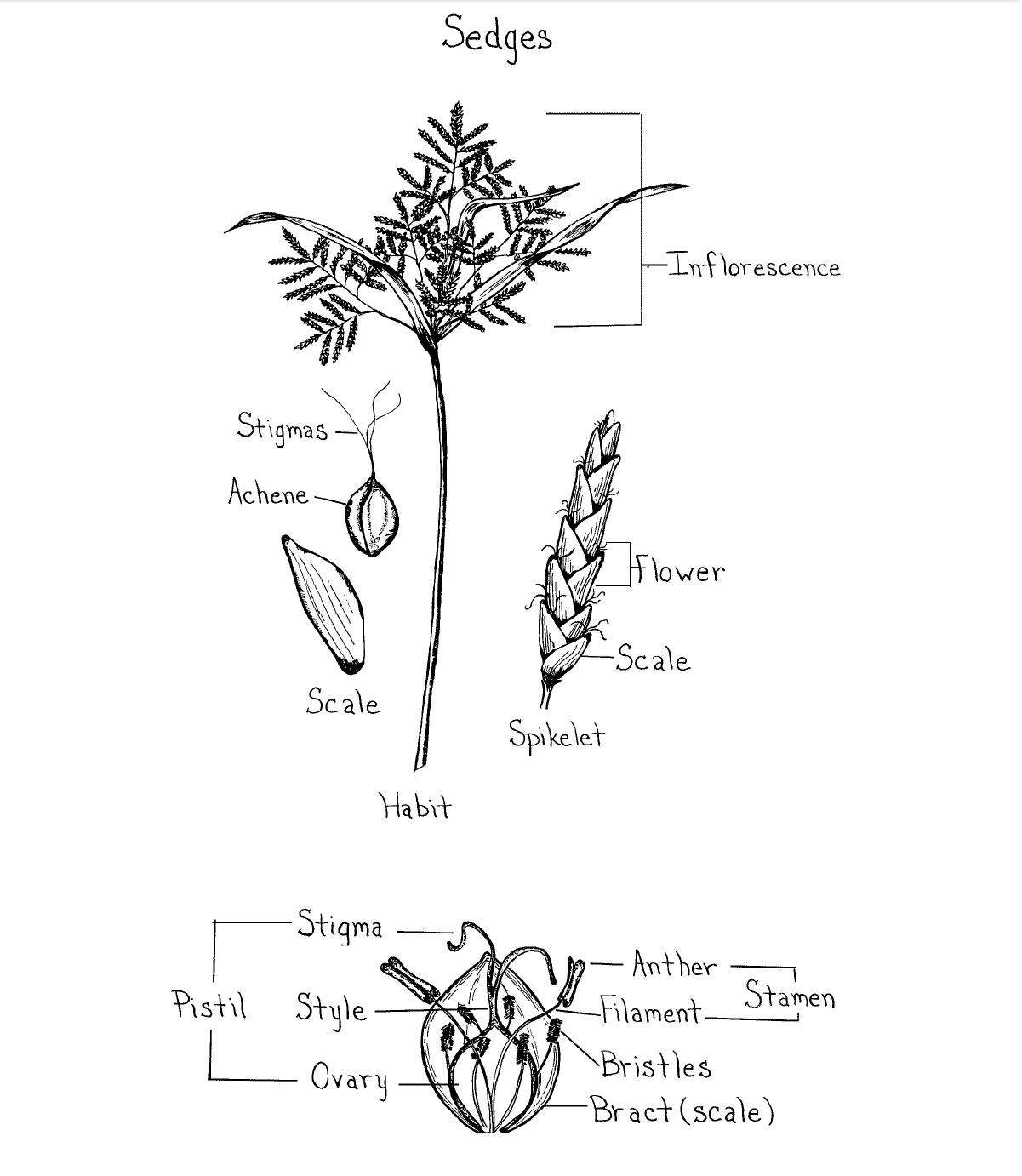 Figure 3. Sedge Floral Parts (Credit: Norman Melvin, USDA Cold Region Research and Engineering Laboratory).
Figure 3. Sedge Floral Parts (Credit: Norman Melvin, USDA Cold Region Research and Engineering Laboratory).Definitions of Terms Shown in the Figures
Achene: A dry single-seeded fruit.
Awn: A bristle-like appendage on a floret or seed, often the extension of veins in glumes or lemmas.
Anther: The male floral part in which pollen is produced.
Blade: The broad, flattened portion of the leaf.
Bract: A modified leaf at the base of the ovary. It is also called a scale.
Bristles: Reduced or modified leaves with numerous hairs, usually in association with the ovary.
Callus: A thickened raised area of hardened tissue.
Collar: The outside area of a grass leaf where the blade and sheath join.
Crown: The basal portion of the plant just above ground level.
Culm: A hollow or pithy stalk or stem.
Filament: The stalk of the male portion of a flower to which the anther is attached.
First glume: The lower of the two glumes and just below the first floret. It is usually the smaller of the two glumes, or it may be entirely absent.
Floret: A unit within a grass spikelet usually comprised of a lemma, palea, two to three lodicules and the grass reproductive parts.
Glumes: The lower one or two sterile bracts at the base of a spikelet.
Inflorescence: A collective term used to describe the overall floral part of the plant.
Internode: The portion of the culm between two nodes.
Lemma: The lower of the two bracts enclosing a flower (floret) above the glumes. It is the most modified of the bracts and the last to disappear.
Ligule: A membranous structure on the adaxial leaf surface adjacent to the sheath.
Lodicules: Modified (reduced) perianth parts.
Nerve: The vein of a glume.
Node: The joint of a grass stem (culm) where the leaves and branches originate.
Ovary: Part of the flower that encloses the ovules containing seeds.
Palea: The inner of the two bracts, enclosed by the edges of the lemma.
Pedicel: The stalk of a single flower.
Pistil: The female floral part.
Rachilla: The secondary axis of a compound leaf or inflorescence.
Scale: Leaflike structure found at the base or outside of the flower. It is also called a bract.
Second glume: The glume opposite to the first, usually larger glume. When the first is lacking, the second glume is on the opposite side of the first floret.
Sheath: The lower part of a grass leaf that encloses the stem.
Shoot: The above-ground portion of a plant.
Spikelet: An inflorescence with one or two glumes at the base and containing one or more florets.
Stamen: The male part of a flower.
Stigma: The distal end of the style, which is receptive to pollen.
Style: Pollen tube connecting the stigma to the ovary.
Stolon: A horizontal above-ground stem that roots along its nodes. It is also called a runner.
Rhizome: A horizontal underground stem.
Warm-season Grasses
Upland Bentgrass, Autumn Bentgrass / Agrostis perennans
Life Cycle: Perennial
Characteristics: A tufted grass having unbranched, leafy light-green culms. Leaf blades are medium green, 1/8 to 1/4 inch wide and 2 to 10 inches long. At the junction of each blade and sheath there is a white membranous ligule. The nodes along each culm are green and swollen. Each fertile culm terminates in an open branched panicle, 3 to 12 inches long and 1 1/2 to 6 inches wide, having a zigzag rachis. Each spikelet has two prominent glumes that resemble a pair of tiny claws. The green inflorescence is more open and airy in shady locations, and it turns tan in fall. The plant self-seeds and forms small colonies. The root system is fibrous.
Cultural Requirements: This grass adapts to a wide variety of cultural conditions, from moist to dry soils in full sun to light shade.
Time of Bloom: September, with spikelets persisting through October.
Suggested Uses: Use Upland Bentgrass in open areas, such as right of ways and meadows.
Georgia Hardiness Zones: All of Georgia
Size: 1 to 3 feet tall
Habitat: Dry or moist thickets, rocky open woodlands, thinly wooded bluffs, wooded openings, prairie swales. In woodlands, it is often found growing at the base of deciduous trees.
Native To: Maine, south to Florida, west to Texas and north to North Dakota.
Comments: A number of caterpillars feed on the foliage, and the seeds are eaten by a variety of birds and mammals. The foliage is grazed by livestock.
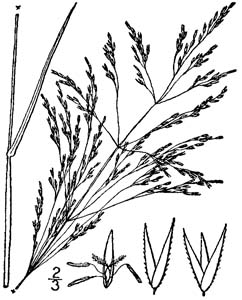 N. L. Britton and A. Brown, NRCSUSDA Plants Database
N. L. Britton and A. Brown, NRCSUSDA Plants Database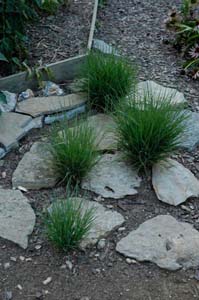 Dropseed Native Plant Nursery
Dropseed Native Plant Nursery
 Gary P. Flemming, Digital Atlas of Virginia Flora
Gary P. Flemming, Digital Atlas of Virginia Flora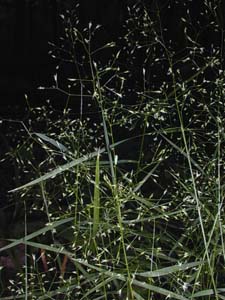 Illinois Wildflowers
Illinois Wildflowers
Big Bluestem, Turkeyfoot / Andropogon gerardii
Life Cycle: Perennial
Characteristics: Big Bluestem is a tall bunch prairie grass often used for grassland restoration in the central and southern plains. It makes premium hay. Leaves are up to 2 feet long and ½ inch wide. Lower leaves are hairy near their bases. Flower clusters are spike-like racemes with purple, brownish purple, yellow or brownish yellow coloration. The flowers rise above the foliage in late summer and branch from one central point into three 4-inch-long segments that some say resemble a turkey's foot. The internodes of flowering stems have a barberpole appearance with rosy or creamy coloration alternating with green. Leaves take on a purple hue in fall and are russet in winter.
Cultural Requirements: Big Bluestem prefers full sun to partial shade and moist, well-drained soils. Once established, it is drought-tolerant. It also can tolerate periodic flooding. When given too much shade, too much water or too much fertilizer it will flop over and look unsightly. It spreads by seed and can be aggressive under good cultural conditions. Mow or cut back the plant in late winter to make way for new spring growth. It also comes back well after controlled burning.
Time of Bloom: August through September, with showy fruit from late September through November.
Suggested Uses: Use Big Bluestem in sunny meadows, open woodlands, wildlife habitats or sunny perennial borders. Its large stature, blue-green foliage, branched seed-heads and russet winter color add visual interest to the landscape. The plant also provides winter protection and food for birds and small mammals. It also is useful for erosion control on slopes.
Georgia Hardiness Zones: All of Georgia
Size: 4 to 8 feet tall
Habitat: Low meadows, dry barrens and woodlands, cliffs, rock outcrops and prairies.
Native To: Most of eastern North America, as far west as Montana and Arizona.
Comments: The flowering stems and leaf sheaths of most of the Andropogon species have a bluish cast on their emerging culms in the spring, so the plants are commonly called Bluestems. Big Bluestem is a larval host for the Delaware Skipper and Dusted Skipper butterflies. It also provides cover and nesting sites for a variety of songbirds. Big Bluestem was once the dominant prairie grass covering a large portion of the Midwest. It was the predominant food source for the millions of bison that once roamed the Great Plains. When settlers plowed under Big Bluestem on their western migration, there was nothing left to keep the dirt from blowing away, so the loss of this plant is said to have contributed to the historic Dust Bowl of the 1930s. Big Bluestem is also a Southeastern grass, especially in the Coastal Plain. It is less common in the Piedmont. It is quick to establish from plugs or seeds planted in late winter or early spring.
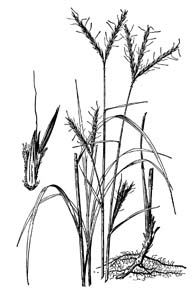 A.S. Hitchcock, USDA PLANTS Database
A.S. Hitchcock, USDA PLANTS Database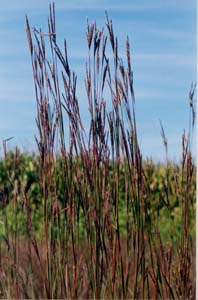 Jennifer Anderson
Jennifer Anderson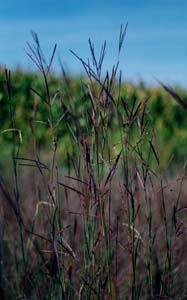 Jennifer Anderson
Jennifer Anderson
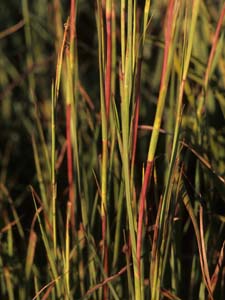 Lady Bird Johnson Wildflower Center
Lady Bird Johnson Wildflower Center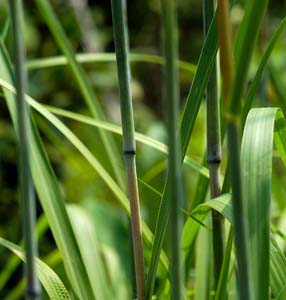 Ed McDowell
Ed McDowell
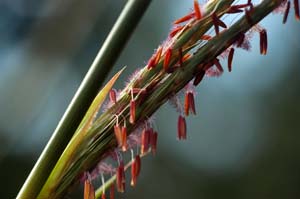 Ed McDowell
Ed McDowell
Bushy Bluestem / Andropogon glomeratus
Life Cycle: Perennial
Characteristics: Bushy Bluestem is a narrow bunch grass with flattened blue-green linear leaf blades up to 10 inches long and ¼ to ½ inch wide. In late summer, dense, silvery-pink to white panicles are borne on the terminals of culms. After the first frost, the foliage and panicles turn bronze and the panicles become fluffy.
Cultural Requirements: Bushy Bluestem prefers full sun and moist to wet soils. It is not tolerant of dry sites. Cut clumps back to the ground in late winter to make way for new spring growth.
Time of Bloom: September. Fruiting stalks linger through February.
Suggested Uses: Bushy Bluestem is a handsome grass for moist, low-lying areas. It provides good erosion control on slopes. Foliage is a larval food source for butterflies, and birds and other wildlife relish the seeds in winter. The plant can spread aggressively under ideal cultural conditions.
Georgia Hardiness Zones: All of Georgia
Size: 3 to 4 feet tall and 2 to 3 feet wide
Habitat: Peripheries of swamps, marshes, low pastures and moist areas.
Native To: New York, south to Florida, west to Arkansas, Oklahoma, New Mexico, Utah and California.
Comments: Flowering plumes hold up well in dried floral arrangements. Bushy Bluestem can be established from plugs or seeds.
 A.S. Hitchcock, USDA PLANTS Database
A.S. Hitchcock, USDA PLANTS Database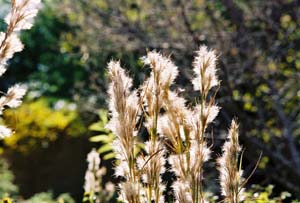 Lady Bird Johnson Wildflower Center
Lady Bird Johnson Wildflower Center
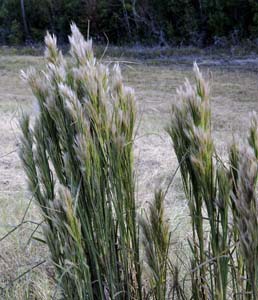 Ed McDowell
Ed McDowell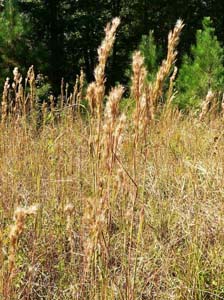 Richard Ware
Richard Ware
Elliot's Bluestem, Elliot's Beardgrass, Elliot's Broomsedge / Andropogon gyrans (syn. Andropogon elliottii)
Life Cycle: Perennial
Characteristics: Elliott's Bluestem is not a very abundant grass where it is found, but it is one of the most conspicuous of all the bluestems. It is a small bunch grass. In the fall, large inflated spathes surround the inflorescences and give the plant a top-heavy look. Inner surfaces of these spathes are copper colored, smooth and shiny. Cultural Requirements: Elliot's Bluestem prefers full sun to partial shade. It will grow on both moist and dry sites and poor soils.
Time of Bloom: September to October
Suggested Uses: Use Elliot's Bluestem in dry, open meadows, open woodlands, on hills or in wildlife habitats.
Georgia Hardiness Zones: All of Georgia
Size: 2 to 3 feet tall
Habitat: Dry to moist open pine or oak woodlands, fields and roadsides.
Native To: New Jersey, west to Illinois, south to Texas and east to Florida.
Comments: Elliot's Bluestem is grazed readily by cattle and has a high protein content when it is green. This grass is quick to establish from plugs. Seeds of this grass are expensive.
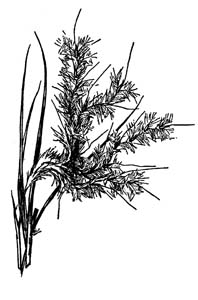 A.S. Hitchcock, USDA PLANTS Database
A.S. Hitchcock, USDA PLANTS Database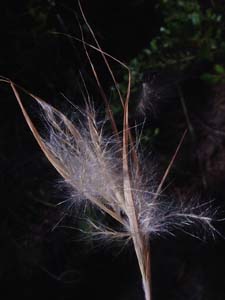 Florida Grasses.org
Florida Grasses.org
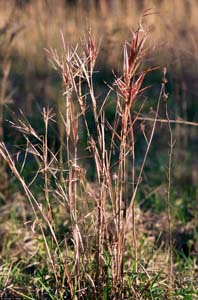 James Miller, USDA PLANTS Database
James Miller, USDA PLANTS Database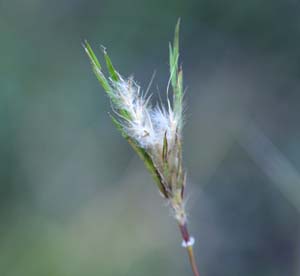 Ed McDowell
Ed McDowell
Splitbeard Bluestem, Silver Bluestem / Andropogon ternarius
Life Cycle: Perennial
Characteristics: Stems have alternating stripes of rose and green along their internodes. They bear narrow blue-green leaves that turn bronze in the fall. In late summer, silvery-white fluffy seed heads are borne along the upper portions of the stems.
Cultural Requirements: Splitbeard Bluestem likes hot, dry sites, full sun to partial shade and infertile sandy soil. Cut plants back in late winter to make way for new spring growth.
Time of Bloom: September
Suggested Uses: Splitbeard Bluestem is a good plant for wildflower meadows, open woodlands or wildlife habitats. It is often mixed with broomsedge in roadside fields. It looks striking in the early morning light.
Georgia Hardiness Zones: All of Georgia
Size: 4 feet tall and 2 feet wide
Habitat: Prairies, meadows, savannas and open woodlands.
Native To: New Jersey, south to Florida, west to Texas, and north to Kansas and Missouri.
Comments: Seeds are eaten by a variety of birds and small mammals. Rabbits browse the foliage. Seed tufts also are used by birds for nesting materials. Tufted stems hold up well in dry floral arrangements. The plant is somewhat slow to establish from plugs or seeds.
 A.S. Hitchcock, USDA PLANTS Database
A.S. Hitchcock, USDA PLANTS Database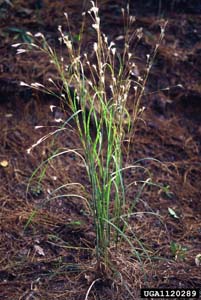 James Miller, USDA Forest Service, Bugwood.org
James Miller, USDA Forest Service, Bugwood.org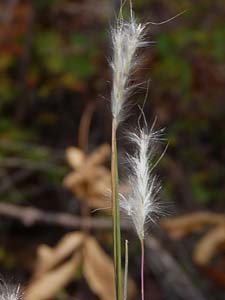 Richard Ware
Richard Ware
Little Bluestem, Bunchgrass (see Schizachyrium scoparium)
Broomsedge / Andropogon virginicus
Life Cycle: Perennial
Characteristics: Broomsedge is a bunch-forming grass. Young stems are green when young, turn coppery bronze as they mature, then fade to tan in fall and winter. Leaves are folded in the shoot and lack auricles at their bases. Leaf blades are approximately ¼ inch wide and 4 to 24 inches long. They are hairy near their bases. In the fall, thin panicles of flowers are produced on the upper half of stems, but they are surrounded by leaves and somewhat hidden. The flowers are inconspicuous until the hairy spikelets start to emerge, dispersing their seeds into the wind.
Cultural Requirements: Broomsedge prefers full sun or partial shade and well-drained soil. It will adapt to both moist and dry sites. It can be controlled with a herbicide should it escape to areas where it is not wanted.
Time of Bloom: September to November
Suggested Uses: Broomsedge is not recommended for cultivated landscapes because it can be invasive. It is considered an exotic invasive plant in Hawaii and California. However, it is an excellent plant for use in wildlife habitats as well as meadow and prairie restoration projects. It also is an excellent plant for reclaiming disturbed land, such as mining sites and landfills. It provides excellent erosion control on slopes.
Size: 3 feet tall and 2 feet wide
Georgia Hardiness Zones: All of Georgia
Habitat: Dry fields, thin woods and the shores of ponds.
Native To: Massachusetts, west to Michigan, Illinois and Iowa, south to Texas and east to Florida. It is also found in the District of Columbia.
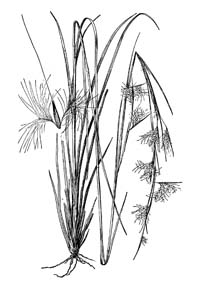 A.S. Hitchcock, USDA PLANTS Database
A.S. Hitchcock, USDA PLANTS Database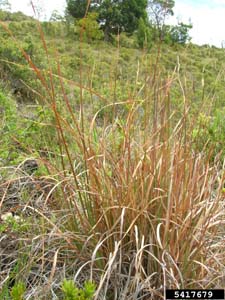 Forest and Kim Starr, Starr Environmental, Bugwood.org
Forest and Kim Starr, Starr Environmental, Bugwood.org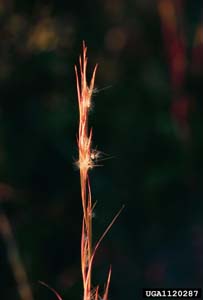 James H. Miller, USDA Forest Service, Bugwood.org
James H. Miller, USDA Forest Service, Bugwood.org
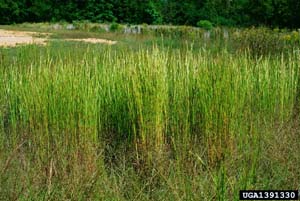 John D. Byrd, Mississippi State University, Bugwood.org
John D. Byrd, Mississippi State University, Bugwood.org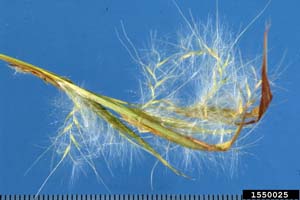 Ken Chamberlain, The Ohio State University, Bugwood.org
Ken Chamberlain, The Ohio State University, Bugwood.org
Arrowfeather Threeawn / Aristida purpurascens
Life Cycle: Perennial
Characteristics: Arrowfeather Threeawn is a clumping grass with stiffly erect culms. Leaves are alternate, 4 to 8 inches long and less than 1/8 inch wide, curled, with a few hairs at their bases. In late summer, purplish-gray panicles, 4 to 12 inches long, are borne on the terminal of nodding culms. Flowers are minute and barely visible to the naked eye. Spikelets have pronounced awns, 1/2 to 3/4 inch long. They drop off a few weeks after the seeds ripen. There are barb-like hairs at the base of seeds that help them anchor to the soil.
Cultural Requirements: Arrowfeather Threeawn grows in full sun to partial shade and dry, well-drained sandy or limestone soils. It adapts to poor soils and is drought-tolerant once established. It spreads readily by seed, so cut back plants before seed set to prevent re-seeding.
Time of Bloom: August to October
Suggested Uses: This grass is primarily used in natural landscapes and habitat restorations.
Georgia Hardiness Zones: All of Georgia
Size: 24 to 30 inches tall
Habitat: Pinelands, prairies and uplands. It is rare in the mountains.
Native To: The eastern United States.
Comments: Arrowfeather Threeawn is the larval host for Meske's Skipper butterfly. It is the most common wiregrass in the Piedmont. This grass is easy to establish from plugs. Seeds are not readily available.
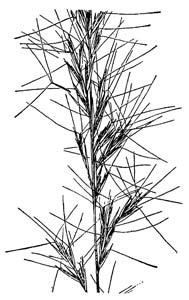 A.S. Hitchcock, USDA PLANTS Database
A.S. Hitchcock, USDA PLANTS Database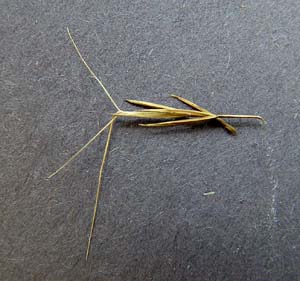 Florida Grasses.org
Florida Grasses.org
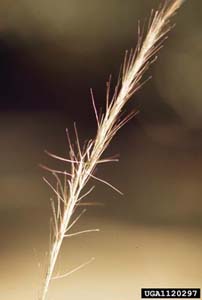 James H. Miller and Ted Bodner, Southern Weed Science Society, Bugwood.org
James H. Miller and Ted Bodner, Southern Weed Science Society, Bugwood.org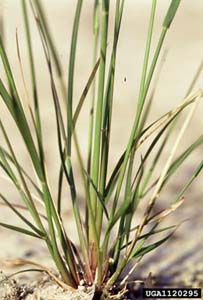 James H. Miller and Ted Bodner, Southern Weed Science Society, Bugwood.org
James H. Miller and Ted Bodner, Southern Weed Science Society, Bugwood.org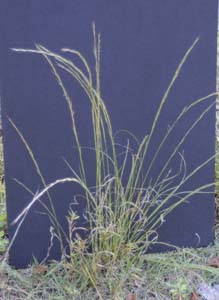 Ed McDowell
Ed McDowell
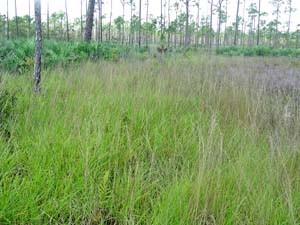 Florida Grasses.org
Florida Grasses.org
Southern Wiregrass, Beyrich Threeawn / Aristida stricta var. beyrichiana (syn. Aristida beyrichiana)
Life Cycle: Perennial
Characteristics: Southern Wiregrass is a fine-textured bunch grass. Leaf blades are approximately 3 feet long and 1/8 inch wide. The blades are hairy, rolled and appear wirelike. The foliage turns chartreuse-yellow in fall. Fire during the growing season encourages flowering. Flowers are tiny and held close to the flower stalk. Each seed has three distinct hair-like awns protruding from one end that look like blades of a helicopter. They help the seeds float in breezes.
Cultural Requirements: Southern Wiregrass prefers sandy, dry soil and full sun to partial shade. Cut the plant back in late winter to encourage new growth. Controlled burning encourages flowering and production of mature seed.
Time of Bloom: Summer
Suggested Uses: Southern Wiregrass is used in habitat restoration projects. It also can be used in perennial borders, rock gardens, meadows and open woodlands.
Georgia Hardiness Zones: 8, 9 (Coastal Plain)
Size: 3 feet tall and 1 foot wide
Habitat: Sandhills, flatwoods and dry prairies in the Coastal Plain. It is a dominant understory plant in longleaf pine savannahs. It is an excellent plant for helping with vegetation management during controlled burning because it burns evenly at the appropriate intensity to kill unwanted vegetation in the understory.
Native To: South Carolina, Georgia, Florida, Alabama and Mississippi.
Comments: Wiregrass grows in habitats favored by gopher tortoises and quail. It provides valuable cover for birds, reptiles and small mammals. The Seminole Indians used this plant to make baskets. Several other Aristida species, both annual and perennial, grow in Georgia. All are characterized by three awns on their seed heads and tan curly leaves at their bases.
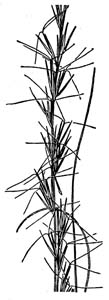 A.S. Hitchcock, USDA PLANTS Database
A.S. Hitchcock, USDA PLANTS Database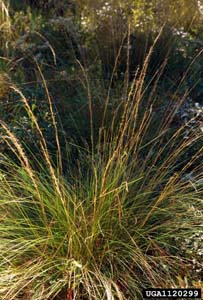 James Miller and Ted Bodner, Southern Weed Science Society, Bugwood.org
James Miller and Ted Bodner, Southern Weed Science Society, Bugwood.org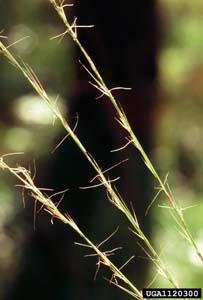 James Miller and Ted Bodner, Southern Weed Science Society, Bugwood.org
James Miller and Ted Bodner, Southern Weed Science Society, Bugwood.org
Side Oats Grama / Bouteloua curtipendula
Life Cycle: Perennial
Characteristics: This is a dense clumping grass with weeping foliage. Leaf blades are narrow, bluish-green, up to 12 inches long and ¼ inch wide. They turn golden brown with a rosy hue in fall. In late summer, numerous spikelets are borne along one side of arching stems that rise above the foliage. The spikelets turn tan in late summer and persist into fall.
Cultural Requirements: Side Oats Grama prefers full sun to partial shade and dry soil having a neutral to slightly alkaline pH. It adapts well to variety of soil types, from clay loams to sandy or rocky areas.
Time of Bloom: July and August
Suggested Uses: This is a good plant for erosion control on slopes or right-of-ways, prairie restoration, wildlife gardens or wildflower meadows. It also is a nice accent plant in perennial borders. Taller grasses often crowd out this grass, so plant it with small, non-aggressive species.
Georgia Hardiness Zones: 7, 8
Size: 3 feet tall and 2 feet wide
Habitat: Limestone glades, dry upland prairies and open rocky woodlands.
Native To: All the U.S., except Nevada, Massachusetts, New Hampshire and Vermont.
Comments: Side Oats Grama is the state grass of Texas. The plant is a food source for the larvae of several butterflies, and the seeds are eaten by a variety of birds. The foliage is grazed by a number of mammals and used by birds as nesting material. It is highly regarded in the shorter grasslands of North America as a forage plant. However, it also is an attractive ornamental plant for use in cultivated landscapes.
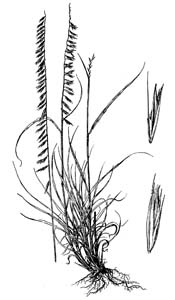 A.S. Hitchcock, USDA PLANTS Database
A.S. Hitchcock, USDA PLANTS Database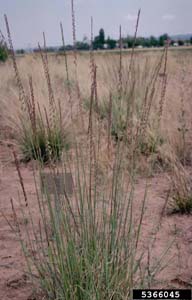 Howard F. Schwartz, Colorado State University, Bugwood.org
Howard F. Schwartz, Colorado State University, Bugwood.org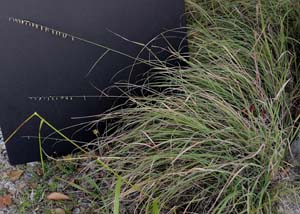 Ed McDowell
Ed McDowell
Sweet Wood Reed, Stout Wood Reed / Cinna arundinacea
Life Cycle: Perennial
Characteristics: Small tufts of erect blue-green culms bear grayish-green leaves 12 inches long and ½ inch wide. The leaf blades tend to droop toward their tips. In late summer, each culm terminates in a gray-green panicle up to 12 inches long and 5 inches across. The spikelets have a reddish-brown hue. The root system is fibrous and rhizomatous.
Cultural Requirements: Sweet Wood Reed prefers partial shade and moist soil having abundant organic matter.
Time of Bloom: August to September
Suggested Uses: Use Sweet Wood Reed for erosion control, in storm-water retention ponds or in wildlife habitats and natural areas.
Georgia Hardiness Zones: All of Georgia
Size: 3 to 5 feet tall
Habitat: Maine, south to Georgia, west to Texas and north to North Dakota and Montana.
Native To: Wooded floodplains, swamps, thickets and damp savannas.
Comments: This is a tall, attractive grass. Birds and small mammals use the plant for food, cover and nesting material.
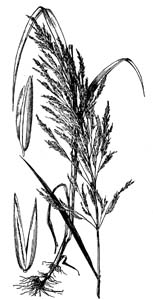 A. S. Hitchcock, NRCS-USDA Plants Database
A. S. Hitchcock, NRCS-USDA Plants Database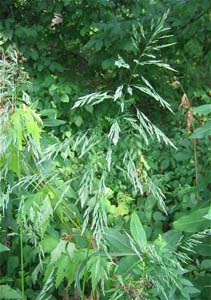 Emmet J. Judziewicz, Robert W. Freckmann Herbarium
Emmet J. Judziewicz, Robert W. Freckmann Herbarium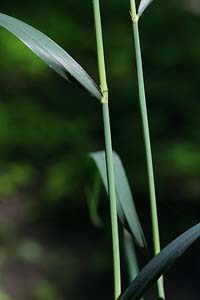 Illinois Wildflowers
Illinois Wildflowers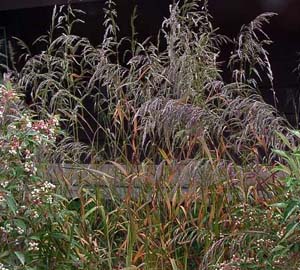 Paul Drobot, Robert W. Freckmann Herbarium
Paul Drobot, Robert W. Freckmann Herbarium
Bigtop Lovegrass, Stout Lovegrass / Eragrostis hirsuta
Life Cycle: Perennial
Characteristics: Leaves are mostly basal, up to 12 inches long and ¼ to ½ inch wide. They are hairy where they join the stem. This bunch grass is barely visible until late August when showy panicles, 4 to 5 feet high and 2 feet wide, rise above the foliage. The silvery-green lacy plumes bear seeds tinged with purple. The inflorescence is airy and floats like a cloud above the foliage. The plant turns whitish-tan in fall.
Cultural Requirements: Bigtop Lovegrass prefers full sun and well-drained soil. It tolerates poor, infertile soil and has good drought tolerance. Seeds are dust-like, germinate readily and can be directly seeded.
Time of Bloom: Late August into October
Suggested Uses: This is an excellent grass for use with larger, more dominant grasses. The airy seed heads allow adjacent plants in bloom to be seen.
Georgia Hardiness Zones: All of Georgia
Size: 3 feet tall and 2 feet wide.
Habitat: Sandy, dry soils. It is mostly found in the Coastal Plain.
Native To: Maine, Massachusetts, New Jersey, south to Florida, west to Texas and north to Illinois and Ohio.
Comments: The fluffy panicles catch the morning dew and sparkle in the sun. This attractive fall bloomer could be used more often in grass seed mixes.
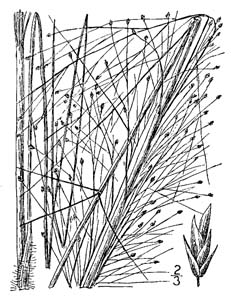 N. L. Britton and A. Brown, USDA PLANTS Database
N. L. Britton and A. Brown, USDA PLANTS Database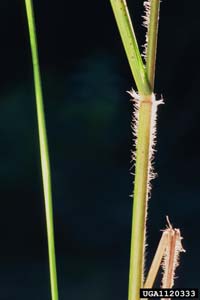 James H. Miller and Ted Bodner, Southern Weed Science Society, Bugwood.org
James H. Miller and Ted Bodner, Southern Weed Science Society, Bugwood.org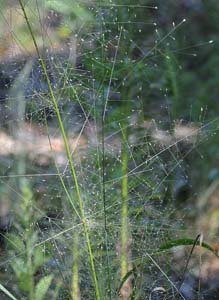 Ed McDowell
Ed McDowell
Purple Lovegrass / Eragrostis spectabilis
Life Cycle: Perennial
Characteristics: This is a fine-textured bunch-forming grass with a stiffly erect growth habit. The leaf sheaths are longer than the internodes and usually hairy at their tops. Leaf blades are up to 12 inches long and 1/8 to 3/8 inches wide, tapering to a fine point. In August, reddish-purple panicles, up to 15 inches long and 20 inches across, rise above the foliage. The panicles are open and airy and have a cloud-like appearance. The panicles turn purplish by late October, then detach from the plant in winter and disperse in the wind like tumbleweed to establish new colonies. Plants spread by seeds and short rhizomes.
Cultural Requirements: Purple Lovegrass prefers full sun to partial shade and well-drained soil. It tolerates poor, infertile soil and has good drought tolerance. It is intolerant of heavy, wet soils.
Time of Bloom: August to October
Suggested Uses: The plant makes an attractive showing when planted in groups in perennial borders, meadows or open woodlands. It is often used for erosion control on banks.
Georgia Hardiness Zones: All of Georgia
Size: 2 feet tall and 1 foot wide
Habitat: Disturbed sandy areas, upland prairies and savannas, limestone glades and along railroads.
Native To: Maine, south to Florida, west to Arizona and north to North Dakota.
Comments: This grass is generally inconspicuous until it blooms. The panicles have a purple glow when dew droplets on the spikelets reflect the morning sun. Purple Lovegrass is easy to establish from plugs. Seeds are expensive. Broadcast seeds on the surface of the soil in late winter or early spring.
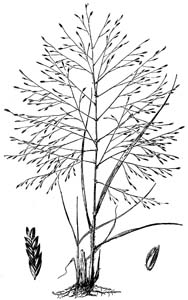 N. L. Britton, USDA PLANTS Database
N. L. Britton, USDA PLANTS Database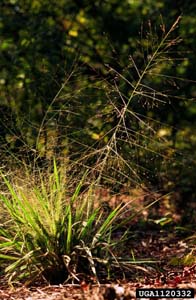 James H. Miller and Ted Bodner, Southern Weed Science Society, Bugwood.org
James H. Miller and Ted Bodner, Southern Weed Science Society, Bugwood.org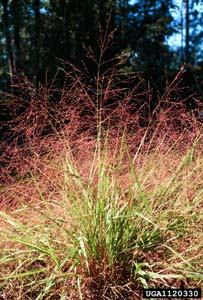 James H. Miller, USDA Forest Service, Bugwood.org
James H. Miller, USDA Forest Service, Bugwood.org
Pink Muhly Grass, Hair-awn Muhly Grass / Muhlenbergia capillaris
Life Cycle: Perennial
Characteristics: Medium-green, erect leaves 2 feet long grow from a basal clump. The leaves are about 1/16 inch wide and either flat or rolled inward. In the fall, masses of airy, pinkish flowers are formed in loosely branched inflorescences, up to 12 inches long. The flowers seem to float like pink clouds above the foliage and make a dramatic statement. The seed plumes are tan and persist throughout the winter.
Cultural Requirements: Pink Muhly Grass prefers full sun to partial shade and moist to dry, well-drained soil. Cut the plant back in late winter to make way for new spring growth.
Time of Bloom: September to October
Suggested Uses: Pink Muhly Grass makes a spectacular showing when planted in groups of three or more plants in perennial borders, wildflower gardens, roadsides, parks or golf courses.
Georgia Hardiness Zones: All of Georgia
Size: 3 feet tall and 3 feet wide
Habitat: Dry, exposed sites, such as rocky clay soils or open woodlands and savannas, in the Piedmont and Coastal Plain. It is restricted to calcareous outcrops in the mountains.
Native To: Massachusetts and New York, south to Florida, west to Texas and north to Kansas, Missouri and Illinois.
Comments: Pink Muhly Grass and Purple Muhly Grass, Muhlenbergia sericea (described below) are almost indistinguishable except by their location and habitat. Pink Muhly Grass is found in upland rocky and clay soils of the Piedmont and well-drained soils of the Coastal Plain, while Purple Muhly Grass is found in sandy areas between coastal dunes. Another species, Savannah Hairgrass or Cutover Muhly, Muhlenbergia expansa, grows in moist to wet acidic bogs, pine savannah and flatwoods in the Coastal Plain. Its flowers are similar to those of the other two species.
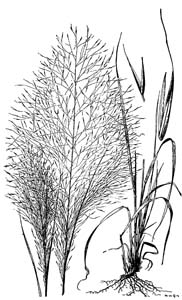 A.S. Hitchcock, USDA PLANTS Database
A.S. Hitchcock, USDA PLANTS Database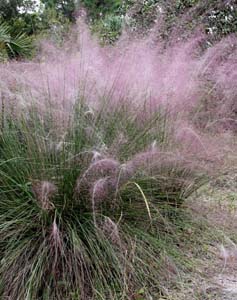 Floridagrasses.org
Floridagrasses.org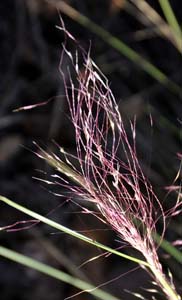 Ed McDowell
Ed McDowell
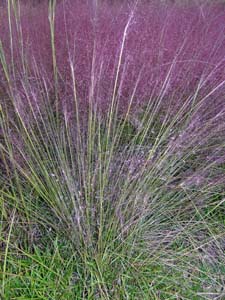 Bobby Hattaway
Bobby Hattaway Bobby Hattaway
Bobby Hattaway
Purple Muhly Grass, Sweetgrass, Dune Hairgrass, Basket Grass / Muhlenbergia sericea (Syn. Muhlenbergia filipes)
Life Cycle: Perennial
Characteristics: Glossy, wiry dark-green leaves 2 feet long grow from a basal clump. In the fall, masses of small, pinkish-red flowers are formed in loosely branched inflorescences, up to 1 to 2 feet long. The airy panicles are an intense pinkish-purple color and appear to float like a cloud above the foliage, making a dramatic statement. After flowering, the seed plumes turn tan and remain on the plant throughout the winter. This species blooms somewhat later than Muhlenbergia capillaris.
Cultural Requirements: Purple Muhly Grass prefers full sun and sandy soil. It tolerates heat, humidity and a wide range of moisture regimes. It adapts to dry sites and is drought-tolerant. Cut the plant back in late winter to make way for new spring growth.
Time of Bloom: Late September to November
Suggested Uses: Purple Muhly Grass makes a dramatic showing when planted in groups in perennial borders, on banks and dry, exposed, full-sun sites. It is an excellent plant for use in parks, along roadsides or on golf courses.
Georgia Hardiness Zones: 8, 9
Size: 4 feet tall and 2 feet wide
Habitat: Purple Muhly Grass is found in the Coastal Plain on low-lying dunes, along the edges of brackish and freshwater marshes and on barrier islands.
Native To: Coastal areas from North Carolina, south to Florida and west to Texas.
Comments: The Gullah people of the Lowcountry in South Carolina, descendants of enslaved Africans, have used Purple Muhly Grass for centuries to make woven sweetgrass baskets. During recent years, urban development and over-harvesting have diminished the native population of Purple Muhly Grass in South Carolina and forced basket makers to Georgia and Florida to find an adequate supply of the grass. This plant is often mistaken for Muhlenbergia capillaris (and vice versa).
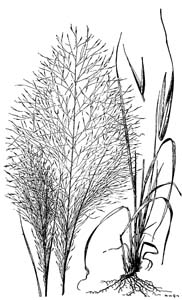 A.S. Hitchcock, USDA PLANTS Database
A.S. Hitchcock, USDA PLANTS Database
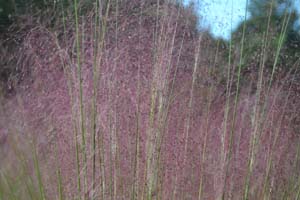 Gary Wade
Gary Wade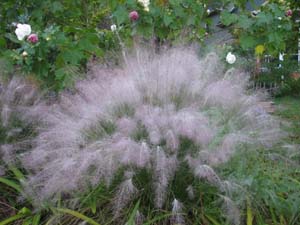 keepthemidlandsbeautiful.org
keepthemidlandsbeautiful.org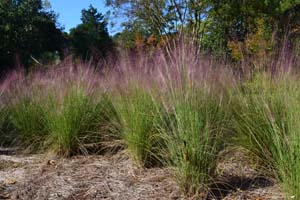 Gary Wade
Gary Wade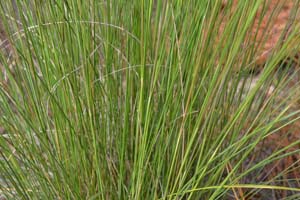 Gary Wade
Gary Wade
Nimblewill, Nimbleweed / Muhlenbergia schreberi
Life Cycle: Perennial
Characteristics: This is a small clumping perennial grass. Leaves are 1 to 3 inches long and 1/8 to 1/4 inch wide and flat, somewhat resembling Bermudagrass. The upper leaf surface has a prominent mid-vein and two lateral veins. Culms are bent at an angle and sprawling. They are light green to pale purple and hairy. In the fall, elongated panicles of spikelets rise above the foliage. They are 3 to 15 inches long, 1 inch wide, purplish green and silky. Plants spread by creeping culms that root at their nodes and by seed dispersal.
Cultural Requirements: Nimblewill prefers full sun to partial shade, moist to mesic conditions and rich loamy soil. It is also adapted to acidic sands and moist rocky areas. It prefers sites that have been previously disturbed.
Time of Bloom: Fall, beginning in October.
Suggested Uses: Nimblewill is one of the few grasses that will thrive in shaded, moist sites. It can be used to suppress the invasive exotic Japanese Stiltgrass, Microstegium vimineum, which also thrives in shaded moist areas. Its non-uniform growth habit makes it an undesirable turfgrass alternative.
Georgia Hardiness Zones: 6, 7
Size: Vegetative parts are less than 8 inches tall. Bloom stalks can reach 15 inches.
Habitat: Moderately moist rocky slopes and ravines, open woodlands and along stream banks.
Native To: Throughout eastern North America, from Texas west to Arizona and north to Utah and South Dakota. It is found at elevations between 200 and 5,000 feet.
Comments: Nimblewill is on the noxious weed list in California where it is not native. It is a good grass for stabilizing soil and suppressing weeds, but it can be invasive in turfgrass. Nimblewill is easy to establish from plugs installed in the early spring or seed broadcast on the surface of the soil in the fall.
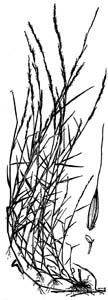 A.S. Hitchcock, USDA PLANTS Database
A.S. Hitchcock, USDA PLANTS Database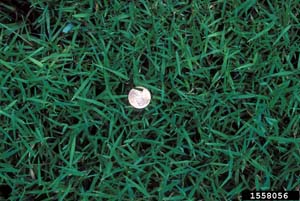 Ohio State Weed Lab Archive, The Ohio State University, Bugwood.org
Ohio State Weed Lab Archive, The Ohio State University, Bugwood.org
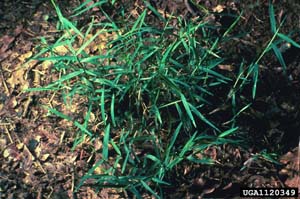 Tim Murphy, University of Georgia, Bugwood.org
Tim Murphy, University of Georgia, Bugwood.org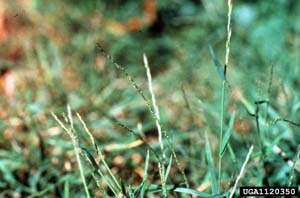 Tim Murphy, University of Georgia, Bugwood.org
Tim Murphy, University of Georgia, Bugwood.org
Beaked Panic Grass / Panicum anceps (Syn. Coleataenia anceps)
Life Cycle: Perennial
Characteristics: Leaf blades are elongated, flat, pubescent, 1/4 to 1/2 inch wide and up to 4 feet long. The inflorescence is an open panicle, 6 to 14 inches long. Spikelets are 1/4 to 1/8 inch long. The second glume of the spikelet is curved at the end and resembles a bird's beak. Rhizomes are scaly and resemble a chicken's foot. The plant spreads by seed and rhizomes and will form colonies.
Cultural Requirements: Plant Beaked Panic Grass in full sun to partial shade. It is less aggressive in shade. It adapts to a wide variety of soils and moisture conditions, from very wet to dry.
Time of Bloom: July to September
Suggested Uses: Beaked Panic Grass is a good plant for stabilizing disturbed erosion-prone areas. Its seed provides food for insects and birds. It also can be used in open woodlands and meadows.
Georgia Hardiness Zones: All of Georgia
Size: 4 feet tall and spreading
Habitat: Woodlands, meadows, margins of freshwater marshes, moist flatwoods, bottomlands, swamps, disturbed fields and roadsides.
Native To: New York, south to Florida, west to Texas and north to Kansas and Iowa.
Comments: Deer may graze the seed heads but do not eat the leaves. The seeds also are eaten by a variety of birds. Birds, reptiles and small mammals use the plant for cover. Beaked Panic Grass is sometimes planted in pastures for grazing by cattle and horses. It is quick to establish from plugs or bare-rooted plants planted in the early spring. It is difficult to establish from seed. This grass is more common in the Piedmont and mountains than Panicum virgatum (described below).
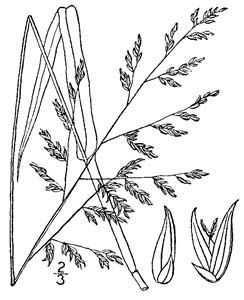 N.L. Britton and A. Brown, USDA PLANTS Database
N.L. Britton and A. Brown, USDA PLANTS Database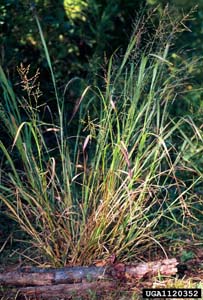 James H. Miller and Ted Bodner, Southern Weed Science Society, Bugwood.org
James H. Miller and Ted Bodner, Southern Weed Science Society, Bugwood.org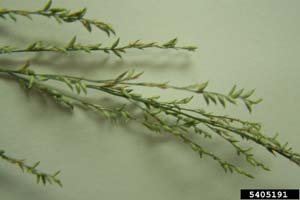 Karan A. Rawlins, University of Georgia, Bugwood.org
Karan A. Rawlins, University of Georgia, Bugwood.org
Redtop Panic Grass / Panicum rigidulum (Syn. Panicum agrostroides, Syn. Coleataenia longifolia)
Life Cycle: Perennial
Characteristics: Stems are erect and hairy. Leaf blades are strongly ribbed, flat, folded at their bases and hairy. They are 8 to 20 inches long and 1/2 inch wide. The inflorescence is a branched panicle borne at the end of the culm. Spikelets are lance-shaped, 1/8 inch long and stalked.
Cultural Requirements: Plant Redtop Panic Grass in full sun and moist to wet soil. It will grow at the edges of ponds and doesn't mind being flooded.
Time of Bloom: August to October
Suggested Uses: This is a wetland plant, so use it in moist meadows or other areas that stay moist or wet.
Georgia Hardiness Zones: 7, 8
Size: 2 to 4 feet tall
Habitat: Wet flatwoods, bogs, swamps and wet edges of ponds and lakes where there are fluctuating water levels. This species is common in the Coastal Plain and rarely encountered in the Piedmont and mountains.
Native To: Maine to Florida, west to Texas and north to Wisconsin. It is also found in California and Oregon.
Comments: Unlike P. anceps and P. virgatum, which spread by rhizomes, this plant does not produce rhizomes. Redtop Panic Grass is easy to establish using plugs or seed. Seed should be broadcast on the surface of the soil in late winter or early spring.
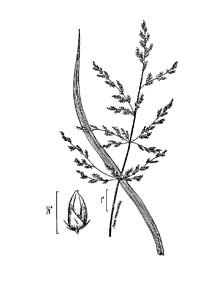 USDA, NRCS, PLANTS Database
USDA, NRCS, PLANTS Database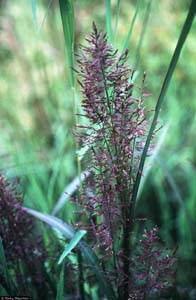 Nancy Staunton, USDA, NRCS PLANTS Database
Nancy Staunton, USDA, NRCS PLANTS Database
Switchgrass / Panicum virgatum
Life Cycle: Perennial
Characteristics: This is a clump-forming grass with a stiff vertical form. Leaf blades are flat, 1/3 inch wide, 2 to 3 feet long and glabrous. They are green in summer and turn pale yellow in the fall. In late summer, pink-tinged, branched flower panicles appear above the foliage like airy clouds. The panicles turn beige as the seeds mature in the fall, and the seed plumes persist well into winter. The plant spreads by seed and rhizomes.
Cultural Requirements: Switchgrass prefers full sun to partial shade and moist, well-drained soil. It will adapt to dry soils and both clay or sandy soils. It can be invasive under ideal growing conditions. If seed dispersal and spread are a concern in cultivated landscapes, it can be cut back before the seeds are mature or confined to a specific area where its spread can be managed.
Time of Bloom: August to November
Suggested Uses: Use Switchgrass in meadows, open woodlands, wildlife habitats, erosion-prone sites or right-of-ways.
Georgia Hardiness Zones: All of Georgia
Size: 3 to 6 feet tall and 2 to 3 feet wide
Habitat: Dry or moist prairies, bluffs, stream banks, pine savannas and open woodlands.
Native To: Most of the continental U.S., except California, Oregon and Washington.
Comments: Switchgrass is one of the most dominant plants in tallgrass prairies of the central and western U.S. Birds use the plant for cover and nesting material, and they eat the seeds. Switchgrass also is a larval host for the Delaware Skipper Butterfly and the Dotted Skipper Butterfly. There are a number of cultivars of this plant in the nursery trade, such as 'Heavy Metal', 'Cloud Nine', 'Shenandoah', 'Northwind', and 'Dallas Blues'. Cultivars used as forage crops include 'Alamo' and 'Cave-in-Rock'. There are both dry and wet ecotypes. Therefore, when collecting seed from natural colonies, make note of the habitat where the plants are growing. The offspring of plants growing on wet sites will not grow well on dry sites and vice versa. Switchgrass establishes quickly from either plugs or seed installed in late winter or early spring.
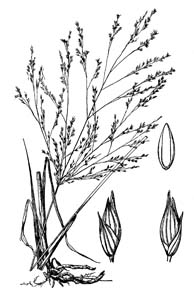 A.S. Hitchcock, USDA PLANTS Database
A.S. Hitchcock, USDA PLANTS Database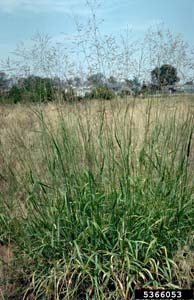 Howard F. Schwartz, Colorado State University, Bugwood.org
Howard F. Schwartz, Colorado State University, Bugwood.org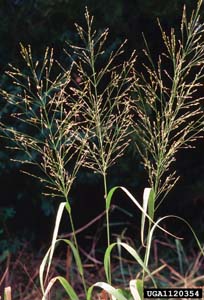 James H. Miller and Ted Bodner, Weed Science Society, Bugwood, org
James H. Miller and Ted Bodner, Weed Science Society, Bugwood, org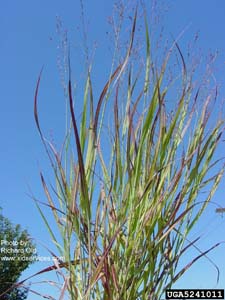 Richard Old, XID Services, Inc., Bugwood.org
Richard Old, XID Services, Inc., Bugwood.org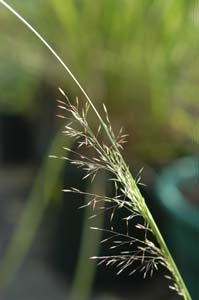 Ed McDowell
Ed McDowell
Silver Plumegrass / Saccharum alopecuroides (Syn. Saccharum alopecuroidum, Erianthus alopecuroides)
Life Cycle: Perennial
Characteristics: Leaves are linear, up to 24 inches long and ½ to 1 inch wide with silver hairs at their bases. They are borne on tall reed-like stems rising 5 to 9 feet. In the fall, silky silvery-purple panicles, 8 to 12 inches long, rise above the foliage. They become more silver as they age, and they persist into winter.
Cultural Requirements: Silver Plume Grass prefers full sun and moist to dry well-drained soil. The plant self-seeds readily, so deadheading is recommended to prevent seed dispersal. Cut the foliage to the ground in late winter to make way for new growth.
Time of Bloom: September to October
Suggested Uses: Plant Silver Plume Grass in open meadows, open woodlands, fields or wildlife gardens. It is often used for habitat restoration. It makes a dramatic statement when several plants are used in the background of perennial borders.
Georgia Hardiness Zones: All of Georgia up to 2,300 feet in elevation.
Size: 3 to 9 feet tall and 2 feet wide
Habitat: Dry open sandy or rocky woodlands, slopes and fields.
Native To: New Jersey, south to Florida, west to Texas and north to Oklahoma, Missouri and Illinois.
Comments: This is an attractive grass that should be used more in landscapes. It is easy to establish from plugs installed in late winter or early spring.
 N.L. Britton and A. Brown, USDA PLANTS Database
N.L. Britton and A. Brown, USDA PLANTS Database Ed McDowell
Ed McDowell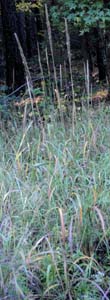 Ed McDowell
Ed McDowell
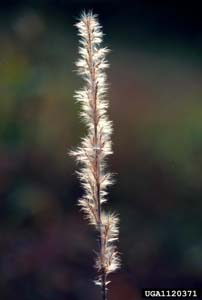 James H. Miller and Ted Bodner, Weed Science Society, Bugwood.org
James H. Miller and Ted Bodner, Weed Science Society, Bugwood.org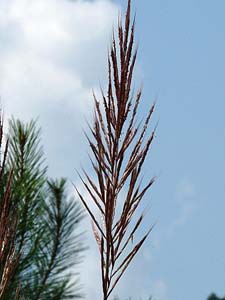 Richard Ware
Richard Ware
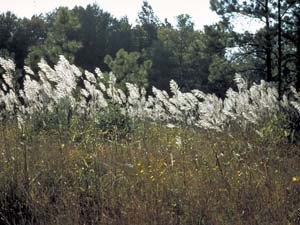 Lady Bird Johnson Wildflower Center
Lady Bird Johnson Wildflower Center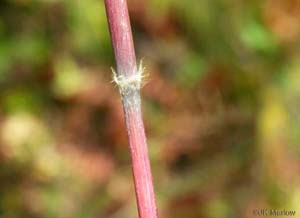 J.K. Marlow Native Plants of the Carolinas and Georgia
J.K. Marlow Native Plants of the Carolinas and Georgia
Giant Plumegrass, Sugarcane Plumegrass / Saccharum giganteum (Syn. Erianthus giganteus)
Life Cycle: Perennial
Characteristics: Giant Plumegrass is a tall, coarse-textured erect plant. Plumes emerge pinkish-red in August, fade to light pink in the fall, then turn silvery-tan in winter. Autumn foliage color is bronze-red.
Cultural Requirements: Plant Giant Plumegrass in full sun or partial shade and moist to wet soil. It adapts to both sandy and clay soils. It makes a dramatic statement when planted adjacent to ponds or in wet ditches. It self-seeds and spreads by rhizomes, so dead-head it before the seeds mature and plant it in a confined area where its growth can be controlled.
Time of Bloom: September to October
Suggested Uses: Giant Plumegrass is best suited for moist meadows, ditches, open woodlands, wildlife habitats, bogs or pond edges.
Georgia Hardiness Zones: 8
Size: 6 to 12 feet tall and 3 to 4 feet wide
Habitat: Moist, open sandy areas, bogs, flatwoods, marshes and swales. It is mainly found in the Coastal Plain.
Native To: New York, south to Florida, west to Texas and north to Oklahoma, Missouri and Illinois.
Comments: This is an attractive grass for moist locations.
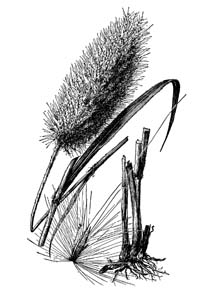 A. S. Hitchcock, USDA PLANTS Database
A. S. Hitchcock, USDA PLANTS Database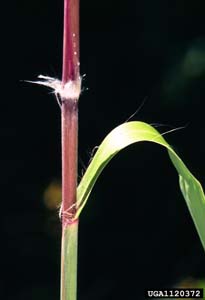 James H. Miller and Ted Bodner, Weed Science Society, Bugwood.org
James H. Miller and Ted Bodner, Weed Science Society, Bugwood.org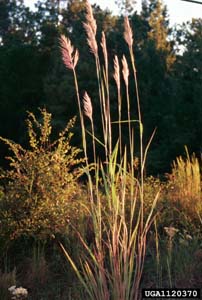 James H. Miller, USDA Forest Service, Bugwood.org
James H. Miller, USDA Forest Service, Bugwood.org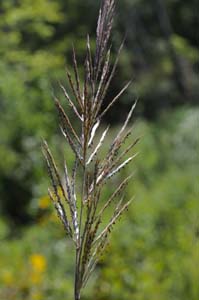 Ed McDowell
Ed McDowell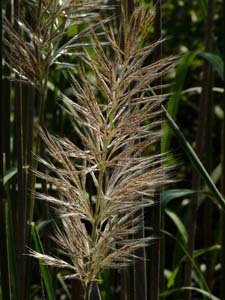 Richard Ware
Richard WareLittle Bluestem, Bunchgrass / Schizachyrium scoparium (Syn. Andropogon scoparium)
Life Cycle: Perennial
Characteristics: Little Bluestem is a dense mounding plant with fine-textured foliage and a distinctive blue-green color. Leaves are 6 to 10 inches long and 1/8 to 1/4 inch wide. In August, purplish-bronze flowers appear on 3-inch-long racemes. They are borne singly or in pairs along a zigzag rachis. The flowering stems have alternating nodes colored wine red and green for a barber pole effect. The foliage turns reddish-brown in fall.
Cultural Requirements: Little Bluestem prefers full sun to partial shade and moderately moist to dry well-drained infertile soil. It will not tolerate wet sites, but it will thrive on poor soils. Mow or cut the plant to the ground in late winter to make way for new spring growth. It re-grows well after prescribed burns.
Time of Bloom: September to October
Suggested Uses: Use Little Bluestem in meadows, wildlife gardens and on erosion-prone sites, such as rights-of-ways and roadsides. Its small stature and bunching growth habit make it a perfect grass for combining with other forbs.
Georgia Hardiness Zones: All of Georgia
Size: 18 to 24 inches tall and 12 inches wide
Habitat: Woodland edges and open woodlands, slopes, prairies, meadows, pastures, rock outcrops, roadsides and savannas.
Native To: Most of the continental U.S., except Nevada and Oregon.
Comments: This plant is a larval host for a wide variety of butterflies, and it provides food, shelter and nesting material for a number of birds and small mammals. The Coastal Plain of Georgia, southeastern Alabama and the Florida panhandle are home to several endemic species of Little Bluestem. Pickett's Mill Historic Site in Paulding County, Ga., is an excellent place to see meadows of Little Bluestem complementing legumes and other forbs in their natural habitat. Little Bluestem is quick to establish from plugs planted in late winter or early spring. It is slow to establish from seed. If seed is used, the site must be completely clear of other vegetation.
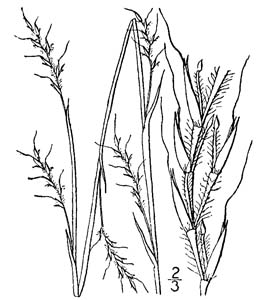 N.L. Britton and A. Brown, USDA PLANTS Database
N.L. Britton and A. Brown, USDA PLANTS Database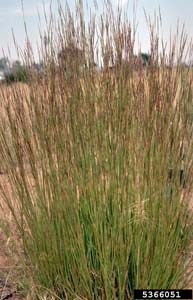 Howard F. Schwartz, Colorado State University, Bugwood, org
Howard F. Schwartz, Colorado State University, Bugwood, org Ed McDowell
Ed McDowell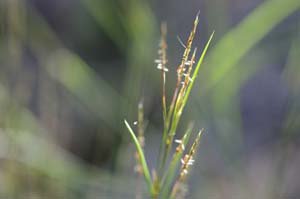 Ed McDowell
Ed McDowell
Knotroot Bristlegrass, Knotroot Foxtail / Setaria parviflora (Syn. Setaria geniculata)
Life Cycle: Perennial
Characteristics: This is a clumping terrestrial (nonaquatic) species. Stems are purple, erect or leaning, 14 to 28 inches long, with swollen nodes. They sometimes root at their nodes when they touch the ground. Leaves are mostly basal, flat, opposite, 1/4 to 1/2 inch wide and 2 feet long with a few hairs at their bases. They often have a glaucous appearance in early summer. Flowering culms rise to 3 feet and bear terminal green panicles, 3/4 inch wide and 2 1/2 to 3 inches long, that turn tan to brown as they mature. Spikelets are subtended by four to seven stiff golden bristles, 1/8 to 1/4 inch long. Plants spread by seeds and rhizomes.
Cultural Requirements: Knotroot Bristlegrass prefers full sun or partial shade and moist soil.
Time of Bloom: Summer
Suggested Uses: Knotroot Bristlegrass is used for wetland and wildlife habitat restorations in coastal meadows near salt marshes. It also can be used at pond edges and on floodplains of streams and rivers.
Georgia Hardiness Zones: All of Georgia
Size: 1 to 3 feet tall
Habitat: Flatwoods, hammocks, fresh and brackish marshes, coastal swales and disturbed sites, such as roadsides.
Native To: Washington, Idaho, south to Arizona, east to Florida and north to Iowa and New York.
Comments: Seeds are grazed by finches. There are several exotic species within this genus, but only two native perennial species: Setaria parviflora and S. macrosperma. Both native species are found in upland and wetland habitats such as fresh or brackish marshes. Knotroot Bristlegrass is easy to establish from plugs or seeds planted in late winter or early spring.
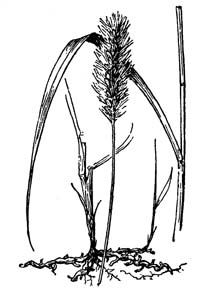 A. S. Hitchcock, USDA PLANTS Database
A. S. Hitchcock, USDA PLANTS Database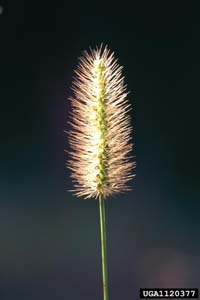 James H. Miller, USDA Forest Service, Bugwood, org
James H. Miller, USDA Forest Service, Bugwood, org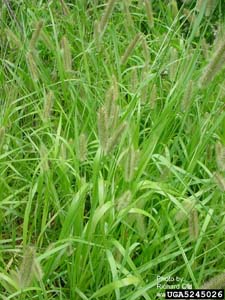 Richard Old, XID Services, Inc., Bugwood.org
Richard Old, XID Services, Inc., Bugwood.org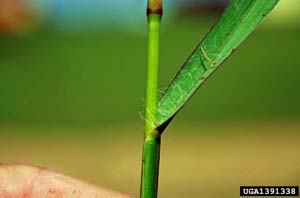 John D. Byrd, Mississippi State University, Bugwood, org
John D. Byrd, Mississippi State University, Bugwood, org
Slender Indian Grass / Sorghastrum elliottii
Life Cycle: Perennial
Characteristics: Slender Indian Grass is a non-rhizomatous clumping bunchgrass. Leaf blades are 8 to 21 inches long and ¼ to ½ inch wide. The inflorescence is an open arching panicle, 5 to 12 inches long. Spikelets are chestnut brown when they mature. Seeds have twisted awns that are 1 to 1½ inches long.
Cultural Requirements: Plant Slender Indian Grass in full sun to partial shade and dry to moist, well-drained sites. This species tolerates more shade and less moisture than S. nutans.
Time of Bloom: September to October
Suggested Uses: Because of its shorter stature and clumping habit, Slender Indian Grass is a good companion plant for forbs and legumes that grow between the grass clumps. Use it in open woodlands, meadows and wildlife habitats. It is an attractive grass for use in perennial borders of cultivated landscapes.
Georgia Hardiness Zones: All of Georgia. In the mountains, it is found in elevations up to 2,000 feet.
Size: 2 to 6 feet tall
Habitat: Dry or mesic open and shaded forests and sandy terraces on river scour areas. The grass is rare in the Blue Ridge Mountains.
Native To: Maryland, south to Florida, west to Texas and north to Oklahoma. It is also found in Indiana.
Comments: Indian grasses have two stiff and straight auricles (ears) at their ligules. This is a good way to distinguish them from other native grasses. Slender Indian Grass is easy to establish from either plugs or seed planted in late winter or early spring. Its seeds have long awns that should be removed before placing them in a seed drill.
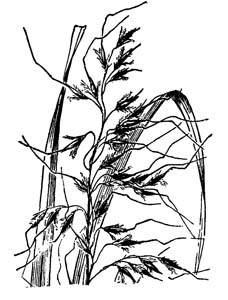 A. S. Hitchcock, USDA PLANTS Database
A. S. Hitchcock, USDA PLANTS Database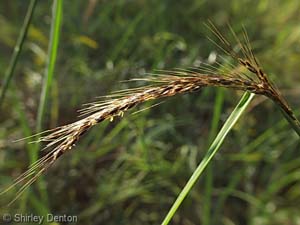 Shirley Denton
Shirley Denton
Yellow Indian Grass / Sorghastrum nutans
Life Cycle: Perennial
Characteristics: Yellow Indian Grass is a tall clumping grass with green or blue-green leaves that are ½ inch wide and 2 feet long. The leaf blades have a pair of prominent auricles at their bases. The foliage turns orange-yellow in the fall and is quite striking in the fall landscape. In late summer, flowering culms rise above the foliage and terminate in narrow feathery, light golden-yellow panicles up to 12 inches long. Seed clusters persist throughout the fall. The plant spreads by seeds and rhizomes.
Cultural Requirements: Yellow Indian Grass will grow in sun or partial shade and is tolerant of a wide range of soils, from sands to heavy clays. It requires abundant moisture during establishment, but it adapts to both dry and moist areas and tolerates occasional flooding. During dry periods, bluish-colored ecotypes have a much more intense bluish color. Mow or cut back plants in late winter to encourage new spring growth. It comes back well after prescribed burns.
Time of Bloom: August to October
Suggested Uses: Use Yellow Indian Grass in wildflower meadows, open woodlands and wildlife habitats. It also is an attractive grass for use in the background of perennial borders. Its rhizomatous root system helps control erosion.
Georgia Hardiness Zones: All of Georgia
Size: 3 to 5 feet tall and 3 feet wide
Habitat: Dry and mesic prairies, open mesic woodlands, fields and dry slopes.
Native To: Most of the continental U.S., except California, Nevada, Oregon, Washington and Idaho.
Comments: Along with Little Bluestem, Big Bluestem and Switchgrass, Yellow Indian Grass is an important species in tallgrass prairies. Cultivars used as forages include 'Cheyenne' and 'Americus'. Birds and small mammals relish the seeds, and the plant parts are used for nesting materials. The plant is a larval host for the Pepper and Salt Skipper Butterfly. Yellow Indian Grass is the state grass of South Carolina. It is easy to establish from either plugs or seeds planted in late winter or early spring. The seeds have a significant beard that should be removed if they are planted with a seed drill.
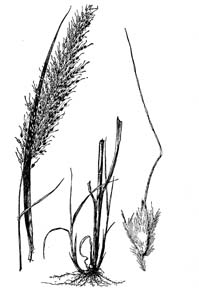 A.S. Hitchcock, USDA PLANTS Database
A.S. Hitchcock, USDA PLANTS Database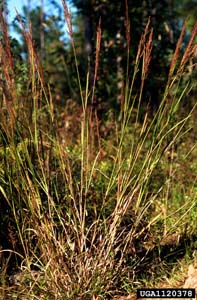 James H. Miller and Ted Bodner, Weed Science Society, Bugwood.org
James H. Miller and Ted Bodner, Weed Science Society, Bugwood.org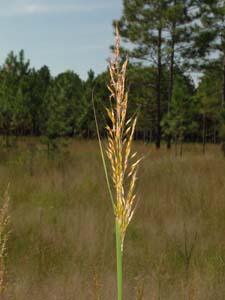 Bobby Hattaway
Bobby Hattaway
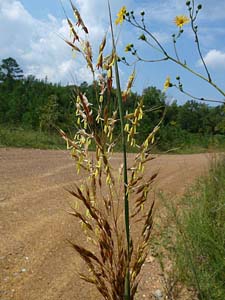 Richard Ware
Richard Ware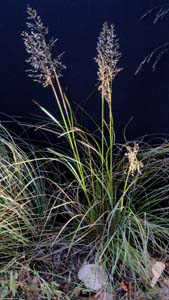 Ed McDowell
Ed McDowell Elaine Haug, USDA-NRCS PLANTS Database
Elaine Haug, USDA-NRCS PLANTS Database
Lopsided Indian Grass / Sorghastrum secundum
Life Cycle: Perennial
Characteristics: This bunchgrass has flat leaf blades less than 1/4 inch wide and 12 to 24 inches long. In September, flower stalks emerge and terminate in panicles 6 to 12 inches long. The inflorescence and seed heads (spikelets) are borne on one side of the stem (rachis), resulting in a lopsided appearance. The spikelets are yellow and fringed with white hairs, giving them a fuzzy silver-and-gold appearance. Each spikelet terminates in a long awn (needlelike projection). The plant spreads by seed and does not produce a rhizome.
Cultural Requirements: Lopsided Indian Grass prefers full sun to partial shade and moist, well-drained sandy soil. It does not like clay soils. It self-seeds readily, so deadhead before seed set if volunteer seedlings are not desired the following year. Cut back plants in late winter to make way for new spring growth.
Time of Bloom: September to October
Suggested Uses: Lopsided Indian Grass can be used in wildflower gardens, open woodlands, meadows or wildlife habitats. It is an attractive grass when used in the background of perennial borders. If seed dispersal and spread are a concern in cultivated landscapes, cut the plants back before the seeds mature.
Georgia Hardiness Zones: 8, 9a (primarily a plant for the Coastal Plain)
Size: 1 1/2 to 3 feet tall. Flower stalks rise to 6 feet.
Habitat: Pinelands, flatwoods and sandhills.
Native To: South Carolina, Georgia, Florida, Alabama, Mississippi, Louisiana, Arkansas and Kansas.
Comments: The plant is a larval host for the Delaware Skipper, Dusted Skipper and Swarthy Skipper butterflies. The species name for this plant comes from the Greek work “secondi,” which means one-sided, referring to the way the spikelets are borne on one side of the rachis.
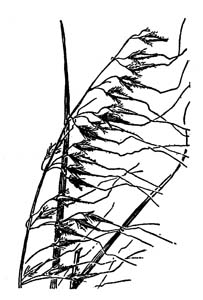 A. S. Hitchcock, USDA PLANTS Database
A. S. Hitchcock, USDA PLANTS Database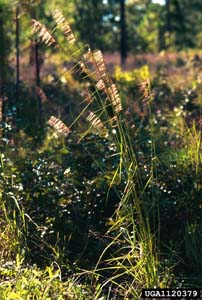 James H. Miller and Ted Bodner, Weed Science Society, Bugwood.org
James H. Miller and Ted Bodner, Weed Science Society, Bugwood.org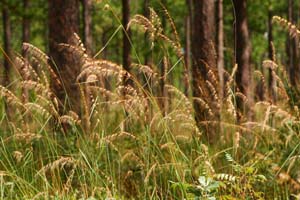 Hugh and Carol Nourse
Hugh and Carol Nourse
Rough Dropseed / Sporobolus clandestinus
Life Cycle: Perennial
Characteristics: Rough Dropseed is a slender tufted grass that remains inconspicuous until the seed heads emerge in the fall. Culms are erect or arching, 12 to 30 inches tall, with swollen nodes. Leaves are 2 1/2 to 12 inches long, about 1/8 inch wide, rolled inward and hairy. In the fall, the terminal flowers are borne at the leaf axils near stem tips. They are somewhat inconspicuous and hidden by the leaf sheaths. Flowers are borne in narrow spikes having 10 to 40 spikelets, 1/4 to 1/2 inch long. Glumes are lance-shaped with greenish mid-veins. There is one fertile floret per spikelet bearing yellow-orange anthers. Seeds shatter at maturity.
Cultural Requirements: Rough Dropseed prefers full sun to partial shade and well-drained sandy or rocky soil.
Time of Bloom: October to November
Suggested Uses: Use Rough Dropseed in open woodlands, meadows, right-of-ways and rocky shoals. Livestock and wildlife will graze the plant when it is young and tender.
Georgia Hardiness Zones: All of Georgia
Size: Up to 30 inches tall and spreading
Habitat: Prairies on sand ridges, flatwoods, savannas, glades, woodlands and limestone bluffs.
Native To: The eastern U.S., from New York to Florida, west to Texas and north to Iowa and Wisconsin.
Comments: The genus name Sporobolus stems from the Greek words spora, which means “seed” and ballein, which means “to cast forth,” referring to the way the plant drops its seeds at maturity.
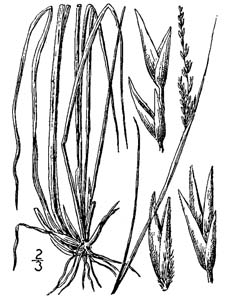 N.L. Britton and A. Brown, USDA PLANTS Database
N.L. Britton and A. Brown, USDA PLANTS Database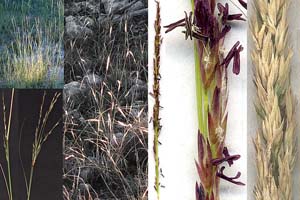 Bob Harms, University of Texas
Bob Harms, University of Texas
Prairie Dropseed / Sporobolus heterolepis
Life Cycle: Perennial
Characteristics: Wiry, thread-like leaves, 1/16 inch wide and up to 20 inches long, grow in a dense weeping clump. The light green to yellow-green foliage turns orange-gold in the fall and fades to light bronze in winter. In late summer, flowering panicles appear on slender stalks that rise above the foliage. The flowers are tinted pink or brown and smell like coriander. Flowers are followed by tiny round seeds that drop to the ground in the fall.
Cultural Requirements: This plant is easy to grow in full sun and well-drained soil. It is slow growing and slow to establish, so it may take three growing seasons to produce a flowering plant. It adapts to a wide variety of soil types, from clays to sands, although it prefers dry, rocky alkaline soils. It has good drought tolerance once established, and it does not like too much moisture.
Time of Bloom: August to September
Suggested Uses: The attractive foliage, fragrant flowers and delicate seed heads are an attractive addition to perennial borders, wildflower gardens, wildlife habitats or rock gardens. It also is a good plant for open woodlands and meadows.
Georgia Hardiness Zones: 6a to 7a
Size: 1½ to 2 feet tall with an equal width
Habitat: Moist prairies, glades or woodlands with alkaline soils. Prairie Dropseed grows naturally on the alkaline soils of Chickamauga Battlefield in the northwestern corner of Georgia.
Native To: Massachusetts, west to Montana, south to New Mexico, Oklahoma, Arkansas, Georgia and North Carolina.
Comments: This grass is considered by many to be one of the most handsome of all the prairie grasses. The somewhat similar Pineywoods Dropseed, Sporobolus junceus (described below), is a good choice for southern Georgia. The Plains Indians ground the seed into a tasty flour. The seed are relished by a variety of birds. Flowering and fruiting is enhanced with recurrent prescribed burns.
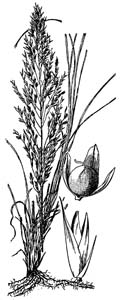 A. S. Hitchcock, USDA PLANTS Database
A. S. Hitchcock, USDA PLANTS Database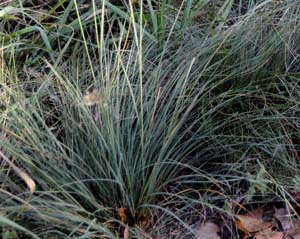 Ed McDowell
Ed McDowell
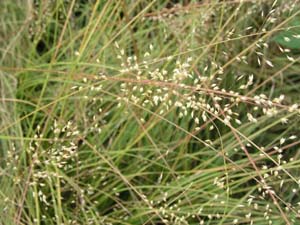 Missouri Botanical Garden
Missouri Botanical Garden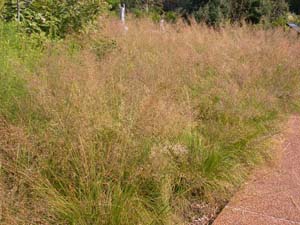 Missouri Botanical Garden
Missouri Botanical Garden
Pineywoods Dropseed, Sandhill Dropseed / Sporobolus junceus
Life Cycle: Perennial
Characteristics: The leaf blade is primarily basal, less than 1/6 inch wide and 8 to 15 inches long with a distinctive blue-green color. A few hairs occur at the base of the leaf blade, and the upper portion of leaf blade rolls inward, resembling a long pine needle. The leaf sheath is round and longer than the internodes. In early fall, bronze to purple branched panicles, 4 to 6 inches long, appear in whorls at the top of flowering stalks. The overall inflorescence has a pyramidal form. Each branch results in one to three seed stalks. The spikelets do not have awns.
Cultural Requirements: Pineywoods Dropseed prefers sun to partial shade and moist well-drained sandy-loam soil. It does not like wet sites.
Time of Bloom: September to October
Suggested Uses: Use Pineywoods Dropseed in moist meadows, open woodlands or wildlife habitats. Its distinctive blue-green foliage and striking panicles make it a handsome grass for use in landscapes.
Georgia Hardiness Zones: 8
Size: 2 to 3 feet tall
Habitat: Flatwoods, open pinelands and savannas, primarily in the sandhill regions.
Native To: Virginia, south to Florida, west to Texas and north to Arkansas, Kentucky and Tennessee. It is also found in Arizona.
Comments: Pineywoods Dropseed is grazed by livestock during early spring. It provides food and cover for birds and small mammals. The plant is enhanced by recurrent controlled burns. It is a groundcover in the sandhill regions of longleaf pine communities. Pineywoods Dropseed is slow to establish from either plugs or seeds planted in late winter or early spring.
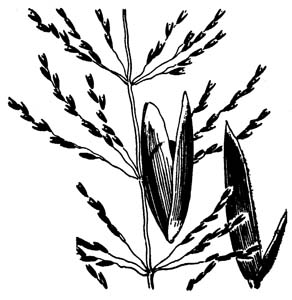 A. S. Hitchcock, USDA PLANTS Database
A. S. Hitchcock, USDA PLANTS Database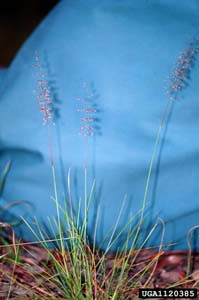 James H. Miller, USDA Forest Service, Bugwood.org
James H. Miller, USDA Forest Service, Bugwood.org
Purpletop, Purpletop Tridens / Tridens flavus
Life Cycle: Perennial
Characteristics: Leaves are alternate, 1/2 inch wide and up to 12 inches long. The upper surface of the leaf is hairy and rough. Each leaf is tightly rolled around drooping stalks (culms). Culms terminate in maroon panicles, 6 to 18 inches long, that droop downward as they mature. They are oily and sticky. Spikelets are 1/4 to 1/3 inch long and purplish green when young, fading to brown when mature. En masse, the plants impart a purple cast to fields. The root system is fibrous and rhizomatous. This grass often goes unnoticed until it flowers in late summer.
Cultural Requirements: Purpletop prefers full sun and slightly moist to dry soil. It adapts to a wide variety of soil types, from clay-loam to sand. It re-seeds readily.
Time of Bloom: Late summer
Suggested Uses: Use Purpletop in meadows, wildlife habitats or dry sunny areas having infertile soil. Because it self-seeds freely, it may not be a good choice for cultivated landscapes.
Georgia Hardiness Zones: All of Georgia
Size: 3 to 6 feet tall
Habitat: Prairies, old fields, savannas, meadows, roadsides and open woods.
Native To: Vermont and New Hampshire, south to Florida, west to New Mexico and north to Minnesota. It is also found in California.
Comments: This is one of the most common native grasses in Georgia. It is a larval host for a wide variety of butterflies, and small mammals eat the foliage. Birds eat the seed and use it for nesting material. Livestock forage on young plants. Another common name for this grass is greasy grass because it harbors tiny insects that emit a greasy substance while they feed on the spikelets. Purpletop is easy to establish from plugs installed in early spring. Seeds are slow to germinate, but they are a cost-effective method of establishment.
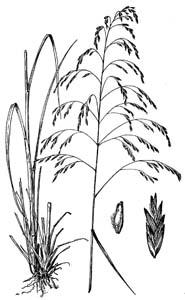 A. S. Hitchcock, USDA PLANTS Database
A. S. Hitchcock, USDA PLANTS Database James H. Miller and Ted Bodner, Weed Science Society, Bugwood.org
James H. Miller and Ted Bodner, Weed Science Society, Bugwood.org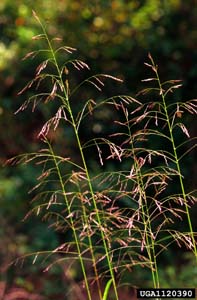 James H. Miller and Ted Bodner, Weed Science Society, Bugwood.org
James H. Miller and Ted Bodner, Weed Science Society, Bugwood.org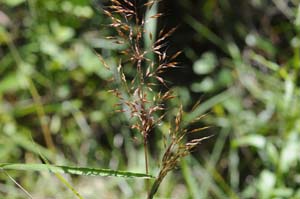 Ed McDowell
Ed McDowell
Eastern Gamagrass / Tripsacum dactyloides
Life Cycle: Perennial
Characteristics: This is a robust, clumping grass with long, arching flat leaves, 1 1/4 inch wide and up to 3 feet long. From May to September, finger-like flower spikes, up to 10 inches long, are borne on stalks extending above the foliage. Male flowers have orange stamens and female flowers have purple stigmas. The plant spreads by seed and creeping rhizomes.
Cultural Requirements: Eastern Gamagrass prefers sun and moist, well-drained soil. It likes moisture and will adapt to wet areas. Cut plants back to the ground after frost kills the foliage. The leaves have razor-sharp edges so be cautious when pruning the plant.
Time of Bloom: Late May to October
Suggested Uses: Plant Eastern Gamagrass in natural areas, moist meadows, wildlife habitats or along ponds. It adapts well to container culture. Its arching foliage, attractive flowers and interesting spikelets make it worthy of landscape culture.
Georgia Hardiness Zones: All of Georgia
Size: 4 to 8 feet tall and 4 to 6 feet wide
Habitat: Borders of wetlands, stream banks, boggy areas, ditches and tallgrass prairies.
Native To: Massachusetts, south to Florida, west to Texas and north to Nebraska, Iowa and Wisconsin.
Comments: Deer, birds and small mammals eat the seeds. Birds, small mammals and snakes use the plants for cover and nesting material. The plant is also the larval host for the Byssus Skipper butterfly. Eastern Gamagrass is considered an ancestor of corn. In open fields it grows in circular clumps, leaving room in the middle for snakes that feed on rodents that are attracted to the seeds. Always look carefully when walking through an area of Eastern Gamagrass to avoid being surprised by a snake. Eastern Gamagrass can be established from plugs or seeds. Plant seeds in the fall for germination the following spring.
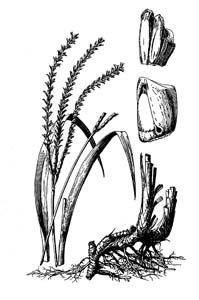 A.S. Hitchcock, USDA PLANTS Database
A.S. Hitchcock, USDA PLANTS Database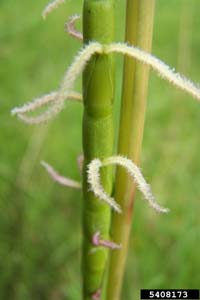 Karan A. Rawlins, University of Georgia, Bugwood.org
Karan A. Rawlins, University of Georgia, Bugwood.org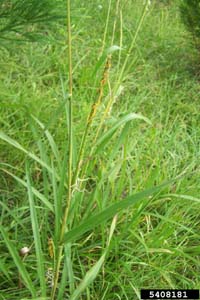 Karan A. Rawlins, University of Georgia, Bugwood.org
Karan A. Rawlins, University of Georgia, Bugwood.org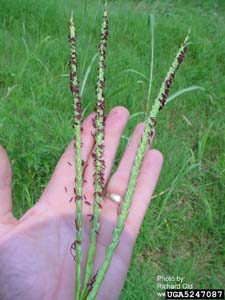 Richard Old, XID Services, Inc., Bugwood.org
Richard Old, XID Services, Inc., Bugwood.orgCool-season Grasses
Ticklegrass, Small Bentgrass, Winter Bentgrass / Agrostis hyemalis
Life Cycle: Perennial
Characteristics: Culms (stalks) are 1 to 3 feet tall and bear three to four alternate leaves. Leaf blades are narrow, up to 1/8 inch across and 2 to 4 inches long. The bases of the leaf blades are wrapped around the culms. In spring, flowering culms terminate in a loose, purplish panicle of spikelets, 6 to 9 inches long. Spikelets have an open, airy appearance and are quite attractive. Seed clusters often break when they are dry and blow around like tumbleweed. The root system is fibrous.
Cultural Requirements: Ticklegrass prefers full sun and moderately moist to dry soil. It will grow in barren disturbed sites containing sand or gravel. It re-seeds prolifically, so cut it back and discard the clippings soon after flowering if re-seeding is not desired.
Time of Bloom: Spring
Suggested Uses: Ticklegrass is commonly used in natural areas, meadows and for reclaiming disturbed areas.
Georgia Hardiness Zones: All of Georgia
Size: 1 to 3 feet tall and 8 to 16 inches wide
Habitat: Woodlands, fields, bogs, sand prairies, meadows, eroded slopes and roadsides.
Native To: Maine, south to Florida, west to Texas and north to South Dakota and Minnesota.
Comments: The wispy spikelets tickle bare skin when one brushes against them, and the seeds hitchhike to new locations on birds, animals and humans.
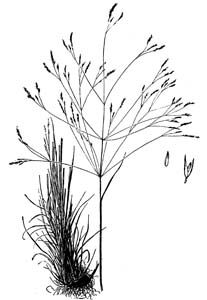 A.S. Hitchcock, USDA PLANTS Database
A.S. Hitchcock, USDA PLANTS Database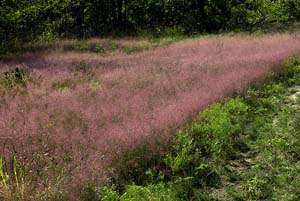 Oklahoma Biological Survey
Oklahoma Biological Survey
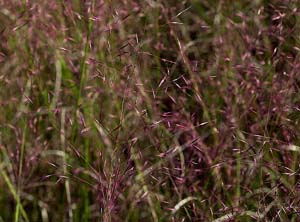 Oklahoma Biological Survey
Oklahoma Biological Survey
Giant Cane, River Cane, Switch Cane / Arundinaria gigantea
Life Cycle: Perennial
Characteristics: Hard woody culms bear coarse, lance-shaped, medium-green leaves up to 12 inches long and 1½ inches wide. The leaves have several pronounced bristles where their leaf sheaths join the culm. Flowers are borne on branched or unbranched stalks arising from the leaf axils and consist of eight to 12 purple flowers. The plant flowers infrequently, perhaps once every 30 years. The plants in an established colony all flower at the same time, and mature, seed-bearing culms die after reproduction. The plant spreads by seeds and rhizomes.
Cultural Requirements: Giant Cane prefers consistently moist soil and full sun to light shade. However, it is widely adaptable, growing at 2,000 feet elevation in the Appalachian Mountains on moist sandy rock cliffs and mountain slopes as well as rich alluvial soils of the Coastal Plain. It also withstands temperature extremes, from -10 °F to 100 °F. When provided its preferred cultural conditions, it will spread and naturalize, creating dense stands called canebrakes. It can be aggressive, so to prevent its spread, confine the plant to a pot or construct soil barriers to confine the rhizomes.
Time of Bloom: February to March
Suggested Uses: Use Giant Cane for erosion control, as a screen plant or adjacent to ponds and streams where it can naturalize.
Georgia Hardiness Zones: All of Georgia
Size: 5 to 12 feet tall (up to 25 feet tall in warm regions) and 8 to 20 feet wide
Habitat: Moist areas along rivers, streams and swamps.
Native To: New York, south to Florida, west to Texas and north to Kansas, Missouri and Illinois. It is primarily found in the Southeast.
Comments: At one time, canebrakes of this plant covered thousands of acres of rich bottomland throughout the Southeast. Native Americans considered these areas prime hunting grounds because they provided food and shelter for a variety of mammals and birds.
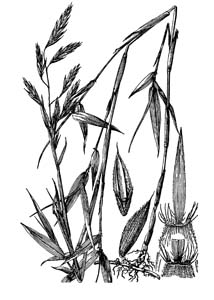 A. S. Hitchcock, NRCS-USDA Plants Database
A. S. Hitchcock, NRCS-USDA Plants Database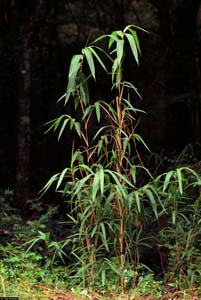 Ted Bodner, NRCS-USDA Plants Database
Ted Bodner, NRCS-USDA Plants Database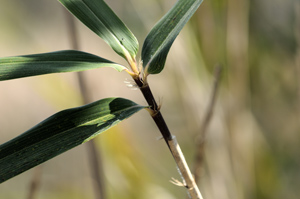 Ed McDowell
Ed McDowell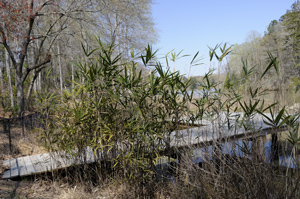 Ed McDowell
Ed McDowell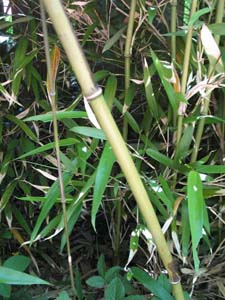 Missouri Botanical Garden
Missouri Botanical Garden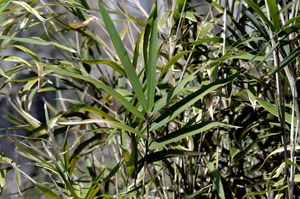 Ed McDowell
Ed McDowell
Hairy Woodland Brome, Common Eastern Brome / Bromus pubescens
Life Cycle: Perennial
Characteristics: Culms are solitary or borne in small clumps. They are erect and hairy. Each culm bears four to 10 leaves that are 6 to 14 inches long and ¼ to ½ inch wide. They are slightly hairy on top and smooth underneath. In May or June, terminal panicles, 4 to 10 inches long, appear at the top of culms. Each panicle produces four to 11 spikelets on short stalks that drop downward. Each floret has pubescence on its glumes and lemmas and a pronounced awn extending from its tip.
Cultural Requirements: Hairy Woodland Brome prefers partial shade to full shade and moist soil. It does not tolerate direct sun or dry soil. Cut back spent seed heads and old foliage after bloom. Growth returns in the fall.
Time of Bloom: May and June primarily, but some may flower in late summer.
Suggested Uses: Hairy Woodland Brome is used primarily as a bottomland plant in stream bank restoration projects.
Georgia Hardiness Zones: All of Georgia
Size: 1 to 3 feet tall
Habitat: Rich moist woodlands, stream banks, sandy roadsides and rocky slopes.
Native To: Maine, south to Florida, west to Texas and north to Wyoming, Colorado and North Dakota.
Comments: Deer, rabbits, livestock and the Eastern Box Turtle browse the foliage. This plant is easy to establish from either plugs or seeds planted in the fall.
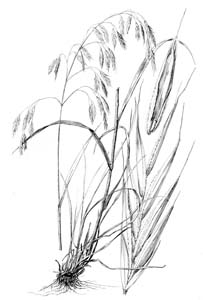 Kansas State University
Kansas State University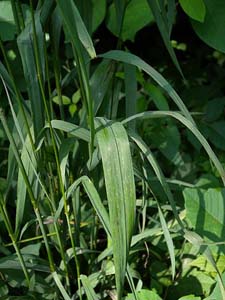 Illinois Wildflowers
Illinois Wildflowers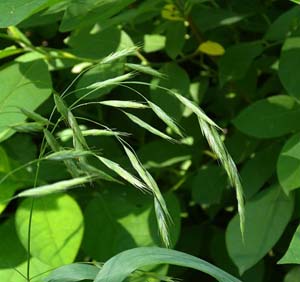 Illinois Wildflowers
Illinois Wildflowers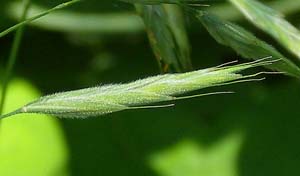 Illinois Wildflowers
Illinois Wildflowers
River Oats, Upland Sea Oats, Northern Sea Oats / Chasmanthium latifolium (Syn. Uniola latifolia)
Life Cycle: Perennial
Characteristics: River Oats is a clump-forming grass with flat, bright-green pointed leaves 5 to 9 inches long and 1 inch wide. In summer, flowering stems rise above the foliage and bear numerous flat clusters of spikelets 1 to 2 inches long and ½ inch wide. The spikelets hang downward from thread-like pedicels in loose, open panicles. The spikelets are green when young, tan when mature and reddish-brown in winter.
Cultural Requirements: River Oats prefers partial shade and moist, well-drained soil. It will adapt to both wet and dry sites as well as poor soils. It self-seeds readily, so deadheading before the seeds turn brown and mature will minimize spread. Cut back plants in early winter to remove old foliage and make way for new growth. It can be invasive in a garden setting.
Time of Bloom: May to July
Suggested Uses: River Oats is a common ornamental grass in the nursery and landscape trade. It is used in perennial borders, wildflower meadows, wildlife habitats and rain gardens. In its natural habitat along the sides of rivers, it stabilizes sand deposited by rising waters.
Georgia Hardiness Zones: All of Georgia, generally less than 2,200 feet elevation in the mountains
Size: 2 to 4 feet tall, 12 inches wide and spreading
Habitat: River Oats is a riparian species found on floodplains, along streams and in moist woodlands adjacent to streams. It also adapts to upland areas and garden habitats.
Native To: New Jersey, south to Florida, west to Arizona and north to Nebraska, Iowa and Wisconsin.
Comments: Seed heads of this plant can be used in dried floral arrangements. The seeds are eaten by small mammals and birds, and the stems and leaves are used by birds for nesting material. A similar species, Longleaf Woodoats, Chasmanthium sessiliflorum (described below), has sessile spikelets (attached directly to the main stalk (culm), while those of C. latifolium are borne on short peduncles that hang downward on the stalk. Also, C. sessiliflorum grows predominantly in the Southeast while C. latifolium has a much wider growing range and is found in the Northeast, Southeast and Midwest. River Oats is easy to establish from plugs planted in the fall. Seeds are slow to germinate.
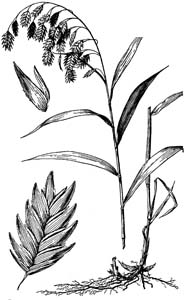 A.S. Hitchcock, USDA PLANTS Database
A.S. Hitchcock, USDA PLANTS Database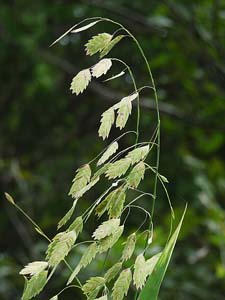 Richard Ware
Richard Ware
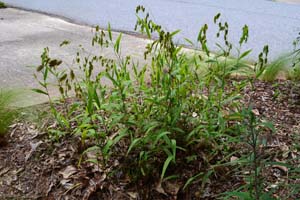 Gary Wade
Gary Wade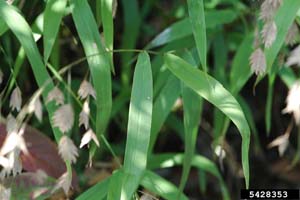 Karan A. Rawlins, University of Georgia, Bugwood.org
Karan A. Rawlins, University of Georgia, Bugwood.org
Longleaf Woodoats / Chasmanthium sessiliflorum (Syn. Uniola sessiliflora)
Life Cycle: Perennial
Characteristics: Longleaf Woodoats is a clumping perennial grass that forms tufted flowers along tall, wiry stems. Leaves are upright, opposite, linear and medium-green. In summer, flowering culms rise above the foliage and bear sparse clusters of yellow-green flowers along their upper half. Spikelets are sessile (stalkless) and attached directly to the culm.
Cultural Requirements: Longleaf Woodoats prefers partial shade and moist sites. Cut back the old foliage in early spring to make way for new growth.
Time of Bloom: June to July
Suggested Uses: Longleaf Woodoats is a good plant for areas managed by prescribed burns and for areas undergoing stream bank restoration. It also is an attractive grass for use in landscapes and wildlife habitats.
Georgia Hardiness Zones: All of Georgia
Size: 3 feet tall and 2 to 3 feet wide
Habitat: Moist hardwoods or pine woodlands and swamps.
Native To: Virginia, south to Florida, west to Texas and north to Arkansas and Kentucky.
Comments: This plant is the most common mesic forest grass in the Southeast. Although it is more common in natural habitats than River Oats, Chasmanthium latifolium, the latter species is more common in the nursery trade, probably because it has greater ornamental value, a wider growing range and better adaptation to dry sites. Longleaf Wood Oats is easy to establish from plugs planted in the fall. Seeds can be broadcast over the soil surface, but they are slow to establish.
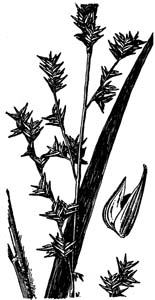 A.S. Hitchcock, USDA PLANTS Database
A.S. Hitchcock, USDA PLANTS Database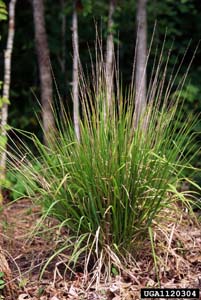 James H. Miller and Ted Bodner, Southern Weed Science Society, Bugwood.org
James H. Miller and Ted Bodner, Southern Weed Science Society, Bugwood.org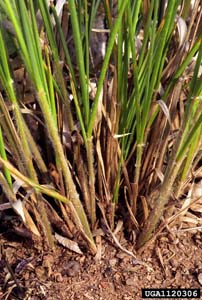 James H. Miller and Ted Bodner, Southern Weed Science Society, Bugwood.org
James H. Miller and Ted Bodner, Southern Weed Science Society, Bugwood.org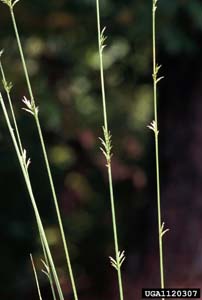 James H. Miller and Ted Bodner, Southern Weed Science Society, Bugwood.org
James H. Miller and Ted Bodner, Southern Weed Science Society, Bugwood.org
Silky Oatgrass, Downy Danthonia / Danthonia sericea
Life Cycle: Perennial
Characteristics: Silky Oatgrass is a medium-size, densely tufted gray-green bunch grass. The sheath that encloses the culm and the leaves has prominent hairs that make it appear silky. The panicle has a long peduncle with a terminal group of spikelets bearing dense white hairs and awns up to 3/4 inch long.
Cultural Requirements: Silky Oatgrass prefers open, dry, sunny sites or the filtered shade of tall pine trees. Clumps usually have spaces between them where spring forbs grow. Cut back spent seed heads and old foliage in the late fall to make way for new growth.
Time of Bloom: May to July
Suggested Uses: Use Silky Oatgrass as a cool-season meadow grass along with flowering forbs. It provides a good backdrop for summer wildflowers. It also can be used in open woodlands and wildlife habitats.
Georgia Hardiness Zones: All of Georgia. It is found predominately in the Piedmont and Coastal Plain.
Size: 8 to 20 inches tall
Habitat: Open dry oak or pine woodlands, roadsides and glades.
Native To: New Hampshire, Massachusetts, Pennsylvania and New Jersey, south to Florida and west to Texas.
Comments: Silky Oatgrass is a larger, hairier species than its cousin, Poverty Oats Grass (described below). Silky Oatgrass is slow to establish from either seeds or plugs. Plant plugs in the fall. This species responds to prescribed burns, particularly if it results in a reduction in the midstory and/or over-story canopy.
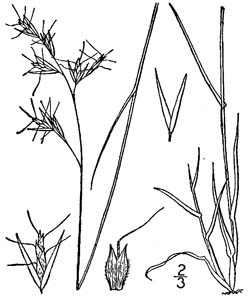 N.L. Britton and A. Brown, USDA PLANTS Database
N.L. Britton and A. Brown, USDA PLANTS Database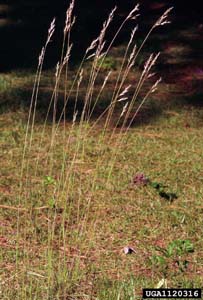 James H. Miller, USDA Forest Service, Bugwood.org
James H. Miller, USDA Forest Service, Bugwood.org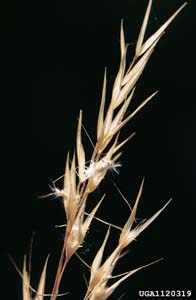 James H. Miller, USDA Forest Service, Bugwood.org
James H. Miller, USDA Forest Service, Bugwood.org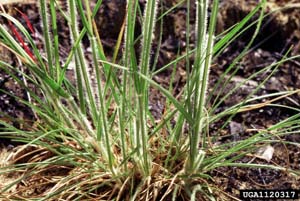 James H. Miller and Ted Bodner, Southern Weed Science Society, Bugwood.org
James H. Miller and Ted Bodner, Southern Weed Science Society, Bugwood.org
Poverty Oatgrass / Danthonia spicata
Life Cycle: Perennial
Characteristics: This grass forms dense tufts of twisted basal foliage. Leaves are medium green, 1/8 inch wide and up to 5 inches long, hairless and twisted. Leaves tend to twist more as they age. They turn tan in winter. Flowering culms rise 1 to 1 1/2 feet and bear narrow terminal branched panicles up to 2 inches long. Spikelets are 1/2 to 3/4 inch long and not particularly showy.
Cultural Requirements: As its name implies, Poverty Oatgrass thrives in infertile soils where many other plants will not grow. It adapts to both sun and partial shade. It does not like wet sites, and it does not tolerate competition from taller plants. Cut back spent seed heads and old foliage in June to encourage new fall growth.
Time of Bloom: April to May
Suggested Uses: Poverty Oatgrass is used primarily for land reclamation, but it also has potential for use in landscapes, such as dry areas of perennial borders or butterfly gardens.
Georgia Hardiness Zones: All of Georgia
Size: 12 inches tall and 6 inches wide
Habitat: Dry pine and mixed pine/oak open woodlands, upland prairies, glades, eroded pastures, crevices of rocks, roadsides and rocky open areas. It colonizes disturbed areas.
Native To: All of the continental U.S., except California, Nevada and Utah.
Comments: Poverty Oatgrass is the larval host for the Chryxus Artic butterfly and the Indian Skipper butterfly. Like Silky Oatgrass, this species also responds to prescribed burns. It is slow to establish from either seeds or plugs. Plant plugs in the fall.
 A. S. Hitchcock, USDA PLANTS Database
A. S. Hitchcock, USDA PLANTS Database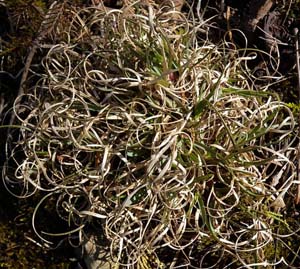 Illinois Wildflowers
Illinois Wildflowers
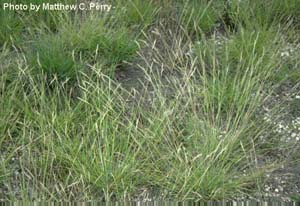 Matthew C. Perry, USGS.gov
Matthew C. Perry, USGS.gov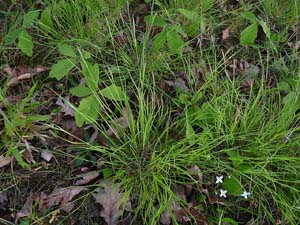 Richard Ware
Richard Ware
Wavy Hairgrass, Common Hairgrass / Deschampsia flexuosa
Life Cycle: Perennial
Characteristics: Wavy Hairgrass grows in a tight clump of narrow, wiry basal foliage. In late spring, flowering culms rise above the plant and bear feathery wands of attractive crinkled spikelets, 12 to 18 inches long. They vary in color from bronze to greenish yellow.
Cultural Requirements: Wavy Hairgrass prefers open conditions at high elevations and partial shade in lower elevations. It also prefers dry to moderately moist, well-drained soil. The plant often turns brown during the heat of summer, particularly at elevations less than 3,000 feet. It does not like to be wet. Plants will self-seed, but they are not invasive. Cut back spent seed heads and old foliage in late summer to make way for new fall growth.
Time of Bloom: May, with seed heads persisting for several months.
Suggested Uses: Use Wavy Hairgrass in wildlife habitats, meadows, open woodlands or shaded areas of perennial borders. It also can be planted in containers.
Georgia Hardiness Zones: 7
Size: 12 to 18 inches tall and about 1 foot wide
Habitat: Throughout its northern range, Wavy Hairgrass grows in rocky slopes and dry woodlands or disturbed sites. In the southern Appalachians it grows at high elevations in grassy balds and rocky summits.
Native To: The eastern U.S., from Maine to Georgia and Alabama. It is also found in Arkansas, Oklahoma, North Dakota, Wisconsin and Michigan.
Comments: Wavy Hairgrass provides food, nesting material and winter cover for a variety of birds and small mammals. It is a showy and tough plant that is easy to grow. The seed heads add an airy touch to dried floral arrangements.
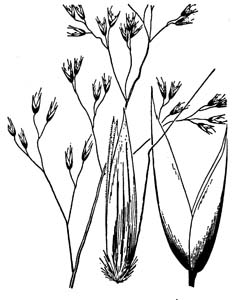 A. S. Hitchcock, USDA PLANTS Database
A. S. Hitchcock, USDA PLANTS Database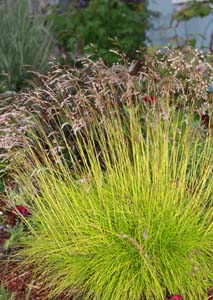 Christine Bingham, Alaska Master Gardener
Christine Bingham, Alaska Master Gardener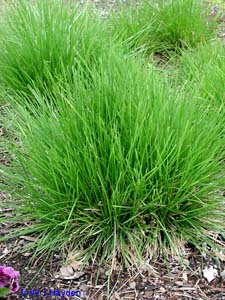 W. J. Hayden, University of Richmond
W. J. Hayden, University of Richmond Ed McDowell
Ed McDowell
Deer-tongue Grass, Deer-tongue Panic Grass / Dichanthelium clandestinum (Syn. Panicum clandestinum)
Life Cycle: Annual
Characteristics: This is a prostrate summer-annual grass. Leaf blades are wide, often exceeding 1 inch in width, and reach 8 inches in length. They are said to resemble a deer's tongue. The bases of the leaf blades are heart-shaped and hairy and completely surround the sheath. Ligules are distinct, 1 mm in length. Leaf sheaths are light green, longitudinally veined and hairy toward their tips. They pull away from the culm at a 45 degree angle. Summer flowers are pyramidal-shaped panicles, 3½ to 5½ inches long and 2½ to 3½ inches wide, with a central rachis and lateral branches. Spikelets are oval in shape, light green to greenish purple. Panicles continue to emerge throughout the fall, but they are smaller and emerge lower on the culm than summer panicles and are often hidden from view. The root system is fibrous and rhizomatous.
Cultural Requirements: Deer-tongue Grass prefers partial sun and moist, well-drained sandy soils. Given ideal conditions, it can spread aggressively.
Time of Bloom: May to September
Suggested Uses: Deer-tongue Grass is sometimes used in moist areas for erosion control.
Georgia Hardiness Zones: All of Georgia
Size: 3 to 4½ feet tall
Habitat: Moist depressions in rocky or sandy woodlands, sandy savannas, sandy prairies, acidic gravelly seeps, moist roadsides and low areas along streams.
Native To: Maine, south to Florida, west to Texas and north to Iowa.
Comments: Several caterpillars feed on this grass, and the seeds are eaten by many birds, especially sparrows, and small rodents. The young foliage is grazed by cattle, horses, sheep, deer and rabbits. It is considered a weed in pastures and open hayfields in the Southeast.
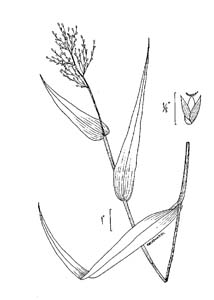 NRCS, USDA Plants Database
NRCS, USDA Plants Database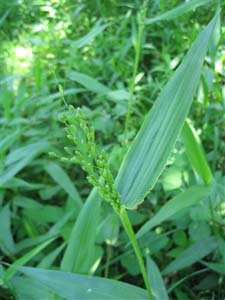 B. S. Walters, University of Michigan Herbarium
B. S. Walters, University of Michigan Herbarium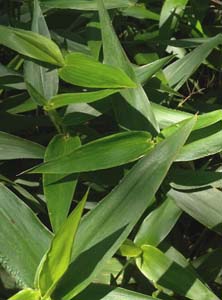 Illinois Wildflowers
Illinois Wildflowers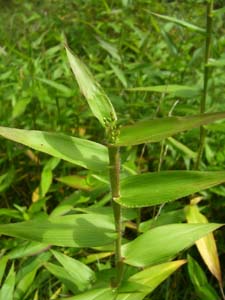 J. Shulman, Botany Dept., Univ. of Wisconsin
J. Shulman, Botany Dept., Univ. of Wisconsin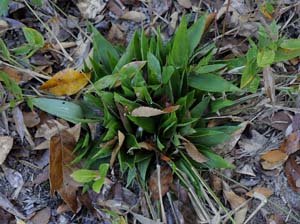 Ed McDowell
Ed McDowell
Open-flower Rosettegrass, Soft Tuft Witchgrass / Dichanthelium laxiflorum
Life Cycle: Perennial
Characteristics: This is a short, densely tufted bunch grass. Leaves are mostly basal, but a few are born on the lower portion of the culm. Leaf blades are 2 to 7 inches long and ¼ to 1 inch wide. The lower internodes are shorter than the upper internodes. Nodes are bearded with soft spreading hairs. In winter the plant turns yellow-green to chartreuse. Two sets of panicles are produced each growing season. The first set, or primary panicles, are up to 6 inches long and 1¼ to 3 inches wide, while the second, later panicles are smaller and more compact.
Cultural Requirements: Open-flower Rosettegrass likes moist areas in sun or partial shade and is adaptable to infertile soils and disturbed sites. It is a tame grass and easy to manage. However, it is often shaded and crowded out by adjacent forbs, so it does require some regular preservation efforts.
Time of Bloom: Primary panicles are produced in April, while secondary panicles are produced from July to early winter. They persist throughout the winter.
Suggested Uses: This grass can be found in many home landscapes where it goes undetected. If left undisturbed, it will slowly multiply and cover the ground. It is a nice grass for perennial borders.
Georgia Hardiness Zones: All of Georgia
Size: Plants are 6 inches tall with bloom stalks rising to 12 inches
Habitat: Open woodlands and moist shaded areas. This is a common grass in poor soils along roadsides and natural areas.
Native To: The eastern U.S., from Pennsylvania to Florida, west to Texas and north to Oklahoma, Missouri and Illinois.
Comments: The attractive chartreuse foliage and nonaggressive nature of this plant make it worthy of landscape culture.
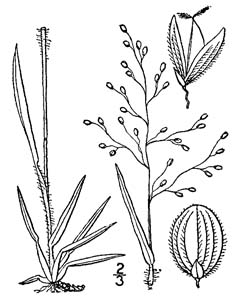 N.L. Britton and A. Brown, USDA PLANTS Database
N.L. Britton and A. Brown, USDA PLANTS Database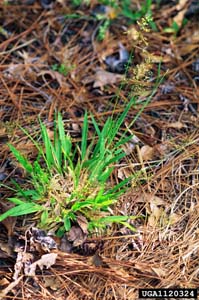 James H. Miller and Ted Bodner, Southern Weed Science Society, Bugwood.org
James H. Miller and Ted Bodner, Southern Weed Science Society, Bugwood.org
Velvet Panicum, Velvet Witchgrass / Dichanthelium scoparium
Life Cycle: Perennial
Characteristics: This is one of the tallest and most coarsetextured of all the Dichanthelium species. Its flat clasping leaf blades are about 5 inches long and 1 inch wide. There is a dense velvety pubescence on the internodes, sheaths and leaf blades and a sticky band below the nodes. The plant flowers twice -- in spring and late summer. Flowers are loose open panicles, 3 to 5 inches long. Each spikelet bears a single creamy white flower rounded at the tip.
Cultural Requirements: Velvet Panicum prefers partial shade and moist to wet soil. Cut plants back after flowering to encourage new growth.
Time of Bloom: May and again in July
Suggested Uses: This is a good plant for stream bank restoration, moist woodlands and moist areas of wildlife habitats.
Georgia Hardiness Zones: All of Georgia, but mostly in the Piedmont and Coastal Plain
Size: 4 to 5 feet tall and 2 feet wide
Habitat: Ditches, bottomlands, marshes, floodplains, bogs and wet meadows.
Native To: Massachusetts, New York and Pennsylvania, south to Florida, west to Texas and north to Kansas, Missouri, Illinois, Indiana and Michigan.
Comments: Velvet Panicum provides a source of food for songbirds, small mammals and game birds. The basal leaves provide winter forage for wild turkey. Although Dichantheliums are called Panicums, botanists have separated them into a different genus from the true Panicums due to their differences in foliage and flowering time. Plants in the Dichanthelium genus flower both in spring and in late summer and have distinctly different foliage in spring and fall. Plants in the genus Panicum, including Switchgrass, Beaked Panicgrass and Redtop Panicgrass, flower only once yearly, and their vegetative appearance does not change appreciably during the growing season. Velvet Panicum is easy to establish from seeds or plugs planted in the fall.
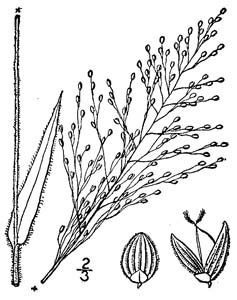 N.L Britton and A. Brown, USDA PLANTS Database
N.L Britton and A. Brown, USDA PLANTS Database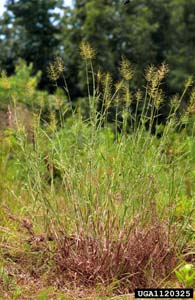 James H. Miller and Ted Bodner, Southern Weed Science Society, Bugwood.org
James H. Miller and Ted Bodner, Southern Weed Science Society, Bugwood.org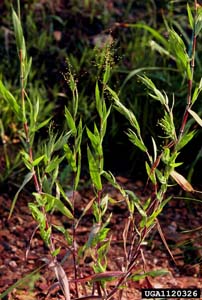 James H. Miller, USDA Forest Service, Bugwood.org
James H. Miller, USDA Forest Service, Bugwood.org
Eastern Bottlebrush Grass / Elymus hystrix (Syn. Hystrix patula)
Life Cycle: Perennial
Characteristics: Eastern Bottlebrush Grass grows in loose upright tufts. Leaves are narrow, rough-textured and up to 12 inches long. In late summer bristly flower heads, 9 to 10 inches long, appear on the terminals of culms that rise above the foliage. The spikelets resemble bottlebrushes and are quite showy. They fade to brown in late summer and persist well into fall.
Cultural Requirements: Eastern Bottlebrush Grass prefers partial shade to full shade and moderately moist, well-drained soil. It adapts to a wide variety of soil types, from sands to clays. It self-seeds readily, so dead-heading is recommended if spreading is not desired. When plants go dormant in late summer, cut them back to ground level to make way for new fall growth.
Time of Bloom: May to June
Suggested Uses: Plant Eastern Bottlebrush Grass in woodland gardens having filtered light.
Georgia Hardiness Zones: 7, 8
Size: 4 to 5 feet tall and 1 to 1 1/2 feet wide
Habitat: Moist forests, glade margins, upland prairies, stream banks and disturbed sites.
Native To: Most of the eastern U.S., from North Dakota to Maine, south to Georgia, Alabama, Arkansas and Oklahoma. It is also found in New Mexico.
Comments: The species name hystrix is a Greek word that means porcupine, in reference to the bristles on the seed heads that resemble the quills of a porcupine. Plants in the Elymus genus can be distinguished by the ear-lobed leaf bases that wrap around their attached stems. Eastern Bottlebrush Grass is easy to establish from plugs or seeds planted in the fall.
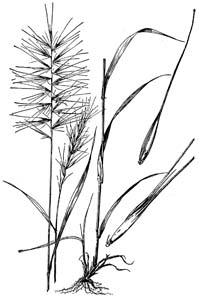 A. S. Hitchcock, USDA PLANTS Database
A. S. Hitchcock, USDA PLANTS Database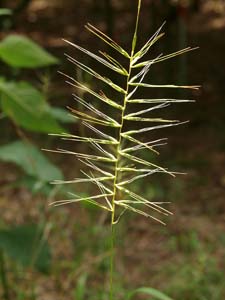 Hugh and Carol Nourse
Hugh and Carol Nourse
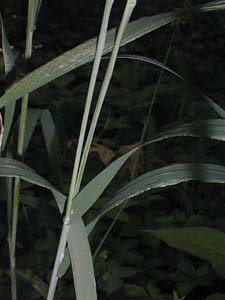 Illinois Wildflowers
Illinois Wildflowers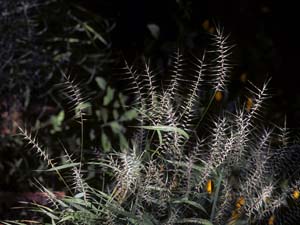 Lady Bird Johnson Wildflower Center
Lady Bird Johnson Wildflower Center
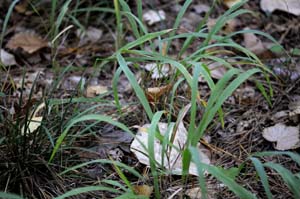 Ed McDowell
Ed McDowell
Virginia Wild Rye / Elymus virginicus
Life Cycle: Perennial
Characteristics: This grass produces erect unbranched culms bearing alternate leaves, 12 inches long and 2/3 inch wide. The leaves are somewhat floppy. Each culm terminates in a floral spike, 2 to 6 inches long, that is partially enclosed in the upper leaf sheath. The inflorescence is a dense cluster of upright spikelets having white or cream-colored anthers. Plants spread by seed and rhizomes.
Cultural Requirements: Plant Virginia Wild Rye in full sun or partial shade and moist, well-drained soil. It adapts to infertile soil on disturbed sites. It sprouts quickly when planted in the fall. Cut old dormant foliage back in summer to make way for new fall foliage.
Time of Bloom: May to June
Suggested Uses: Virginia Wild Rye is used for stabilizing disturbed, erosion-prone soil. It does particularly well along woodland streams and floodplains. It also can be planted in meadows and at the edges of woodlands. It is a good plant for areas where Japanese Stiltgrass, an invasive exotic plant, has been eradicated.
Georgia Hardiness Zones: All of Georgia
Size: 4 to 5 feet tall and 2 feet wide
Habitat: Shaded forests, banks and roadsides, fence rows and open woodlands.
Native To: Most of the continental U.S., except California, Nevada, Utah, Colorado, Idaho, Montana, Oregon and Washington.
Comments: Plants are a larval host for several species of butterflies. Cattle graze on the foliage. Virginia Wild Rye is easy to establish from plugs or seeds planted in the fall.
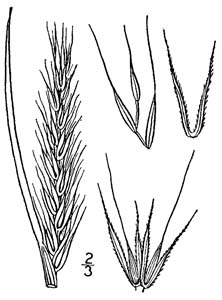 N. L. Britton and A. Brown, USDA PLANTS Database
N. L. Britton and A. Brown, USDA PLANTS Database Dan Tenagli, Missouriplants.com, Bugwood.org
Dan Tenagli, Missouriplants.com, Bugwood.org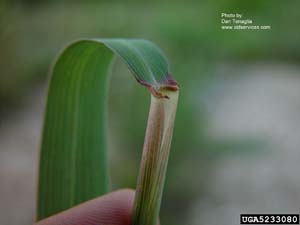 Dan Tenagli, Missouriplants.com, Bugwood.org
Dan Tenagli, Missouriplants.com, Bugwood.org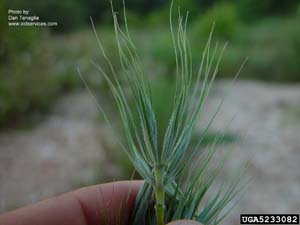 Dan Tenagli, Missouriplants.com, Bugwood.org
Dan Tenagli, Missouriplants.com, Bugwood.org
Fowl Mannagrass / Glyceria striata
Life Cycle: Perennial
Characteristics: Smooth unbranched culms bear four to six alternate chartreuse leaves 12 inches long and ¼ inch wide. Each culm terminates in a panicle of spikelets 12 inches long and 6 inches across. The panicle is pyramidal in shape with the longest branches at the bottom, tapering in length toward the top. The branches of the panicles occur in whorls of two to four and tend to droop downward. Spikelets are small, purplish green and turn greenish yellow then tan as they mature. The grass spreads predominately from seed.
Cultural Requirements: Fowl Mannagrass prefers full sun, partial shade to full shade and moist to wet loamy soil. Cut back foliage in mid-summer to make way for new fall growth.
Time of Bloom: April
Suggested Uses: Fowl Mannagrass is used for stream bank and wildlife habitat restorations, in floodplains, along ponds, in moist meadows and other moist to wet sites.
Georgia Hardiness Zones: All of Georgia
Size: 2 to 3½ feet tall and 2 feet wide
Habitat: Wet meadows, marshes, bogs and ditches.
Native To: All of North America.
Comments: Fowl Mannagrass provides cover for birds and small mammals. Canada geese eat the foliage. The greenish yellow foliage and drooping floral spikelets are attractive features of this plant. The grass is easy to establish from plugs or seeds planted in the fall.
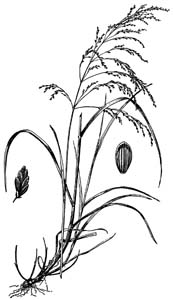 A. S. Hitchcock, USDA PLANTS Database
A. S. Hitchcock, USDA PLANTS Database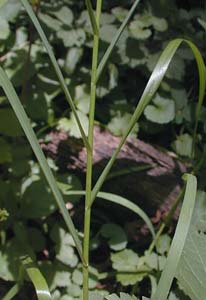 Illinois Wildflowers
Illinois Wildflowers
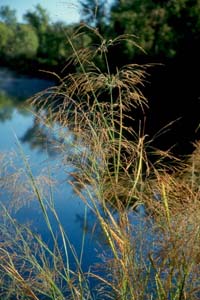 Pitt State Herbarium
Pitt State Herbarium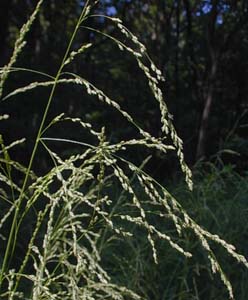 Illinois Wildflowers
Illinois Wildflowers
Little Barley / Hordeum pussillum
Life Cycle: Annual
Characteristics: Little Barley is a tufted grass with several branching culms originating from a center crown. Culms are light green and slender with one to three leaves along their lower half. Leaf blades are 3/4 to 2 1/2 inches long and 1/8 inch wide. They are bluish-green, hairless and flat. Nodes are dark-colored and swollen. Each culm terminates in an unbranched erect bristly spike of narrow, greenish-brown spikelets. Glumes have pronounced awns. The root system is shallow and fibrous.
Cultural Requirements: Little Barley prefers full sun and dry, well-drained alkaline soils containing sand or gravel.
Time of Bloom: April to May
Suggested Uses: Use Little Barley in open meadows and open areas of wildlife habitats. It does well in infertile soils where little else will grow.
Georgia Hardiness Zones: All of Georgia
Size: 8 to 18 inches tall
Habitat: Dry, alkaline gravelly soils along roadsides and railroads, overgrazed pastures, dry stream banks, fallow fields and waste areas. It often colonizes disturbed sites.
Native To: All of the continental U.S.
Comments: This plant is a relative of the cultivated grain barley (Hordeum vulgare). The seeds are valued by birds, grasshoppers and a number of small mammals. The starchy seeds were boiled, parched and roasted by indigenous people in eastern North America before the arrival of maize.
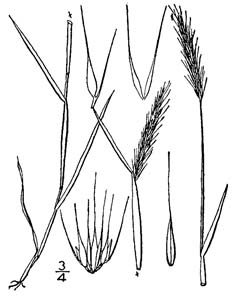 N.L.Britton and A. Brown, USDA Plants Database
N.L.Britton and A. Brown, USDA Plants Database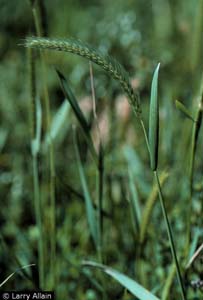 Larry Allain, NRCS-USDA Plants Database
Larry Allain, NRCS-USDA Plants Database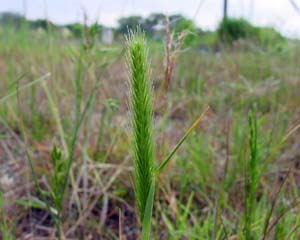 Sam C. Strickland, Wildflowers.org
Sam C. Strickland, Wildflowers.org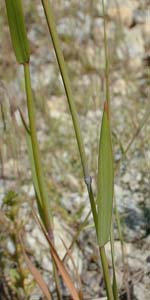 Illinois Wildflowers
Illinois Wildflowers
Two-flower Melicgrass / Melica mutica
Life Cycle: Perennial
Characteristics: Two-flower Melicgrass grows in loose clumps. Some leaf sheaths have a smooth surface while others are covered in downy fine hairs. Leaf blades are flat, 6 to 8 inches long and 1/4 inch wide. The flowering culms have numerous branches and are 12 to 24 inches long. Spikelets are 3/8 to 5/8 inch long. They hang downward and give the inflorescence a one-sided appearance. The plant spreads by rhizomes and seed. When seeds are ripe, they shatter quickly.
Cultural Requirements: Two-flower Melicgrass prefers shade and moist, well-drained soil. Growth begins in early winter and accelerates in early spring.
Time of Bloom: March to May
Suggested Uses: Two-flower Melicgrass has attractive foliage, and its flowering culms complement spring forbs or ferns. Cut back the foliage after the seed heads shatter to encourage new growth in the fall.
Georgia Hardiness Zones: All of Georgia
Size: 1½ feet tall
Habitat: Open areas of woodlands, stream banks, moist rocky forests and roadside ditches.
Native To: New Jersey, south to Florida, west to Texas and north to Oklahoma. It is also found in Iowa, Illinois and Indiana.
Comments: Two-flower Melicgrass grows in deciduous forests where it gets sun, grows and flowers in early spring before the leaves of trees emerge. Then, when the trees leaf out and cast shade, the grass goes dormant. This grass is best established from plugs planted in the fall.
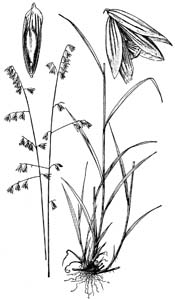 A.S. Hitchcock, USDA PLANTS Database
A.S. Hitchcock, USDA PLANTS Database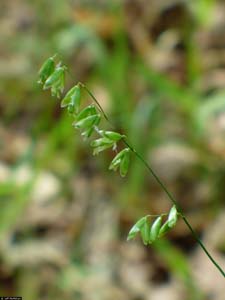 Jeff McMillian, USDA-NRCS PLANTS Database
Jeff McMillian, USDA-NRCS PLANTS Database
Blackseed Speargrass, Blackseed Needlegrass, Black Oatgrass / Piptochaetium avenaceum (Syn. Stipa avenaceum)
Life Cycle: Perennial
Characteristics: Blackseed Speargrass is a dense clump-forming cool-season grass with basal leaves. The leaves are dark green, 4 to 12 inches long, 1/8 inch wide and weeping. The underside of the leaves is scaly. Old leaves become tan and curly. The inflorescence is an open drooping panicle with single-flowered spikelets. Florets within the spikelet are 3/4 to 1 1/2 inches long and have twisted awns 2 to 3 inches long. Seeds turn black at maturity, and their awns remain attached. After the seed heads shatter, the pale tan glumes remain on the plant as it goes dormant in summer.
Cultural Requirements: Blackseed Speargrass prefers dry sandy or rocky soil and full sun to partial shade. Seeds with awns intact tend to germinate best; the awns twist with changes in humidity and help the seeds anchor themselves to the soil. Seeds shatter quickly when mature. Cut plants back in mid-summer to make way for new foliage in the fall. The plant goes dormant in summer, then new growth begins in the fall and accelerates in late winter into early spring.
Time of Bloom: April to May
Suggested Uses: Blackseed Speargrass is a nice ground cover for dry shady hillsides in an oak/hickory forest. It also likes open woodlands and meadows. It is quite attractive in May when the young seed heads blow in the wind.
Georgia Hardiness Zones: All of Georgia
Size: 3 feet tall and 1 foot wide
Habitat: Dry, West-facing, partially open woodlands, rocky slopes, clearings and edges of forests.
Native To: Massachusetts, south to Florida, west to Texas and north to Michigan.
Comments: Blackseed Speargrass is the only native speargrass species east of the Mississippi River. Children love to harvest the stems and pretend they are spears. The awns of mature seeds help the seeds stick to clothing for transport to other locations. Seeds can be planted in the fall, but they may take one to two years to germinate.
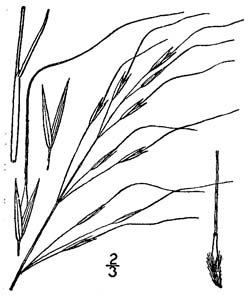 N.L. Britton and A. Brown, USDA PLANTS Database
N.L. Britton and A. Brown, USDA PLANTS Database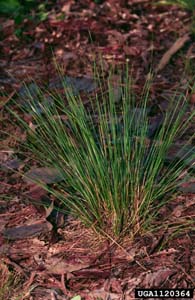 James H. Miller and Ted Bodner, Weed Science Society, Bugwood.org
James H. Miller and Ted Bodner, Weed Science Society, Bugwood.org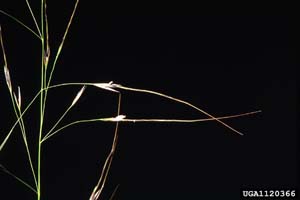 James H. Miller and Ted Bodner, Weed Science Society, Bugwood.org
James H. Miller and Ted Bodner, Weed Science Society, Bugwood.org
Early Bluegrass / Poa cuspidata
Life Cycle: Perennial
Characteristics: Early Bluegrass starts growing in the early fall, with peak growth in winter and early spring. It is a loosely tufted grass with short rhizomes. Culms are not branched above their bases. The medium-green leaf blades are 1/8 inch wide and 12 to 18 inches long with curved tips. Panicles are erect, 2 to 6 inches long and pyramidal in shape.
Cultural Requirements: Early Bluegrass likes sandy, moist soil and partial shade. Cut the plant back after flowering to make way for new fall foliage.
Time of Bloom: March to April
Suggested Uses: Early Bluegrass is a nice short winter grass for shady moist areas of woodlands and wildlife habitats. It will not overwhelm emerging ferns and other spring forbs.
Georgia Hardiness Zones: 6, 7
Size: 1/2 to 2 feet tall
Habitat: Floodplains, stream banks and moist shady slopes.
Native To: The eastern U.S., from New York, west to Indiana, south to Louisiana and east to Georgia.
Comments: Other native bluegrasses in Georgia, Poa autumnalis, Poa sylvestris and Poa palustris, bloom later than Poa cuspidata.
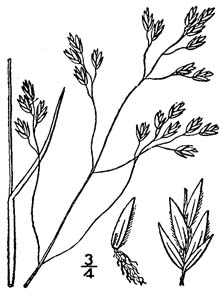 N.L. Britton and A. Brown, USDA PLANTS Database
N.L. Britton and A. Brown, USDA PLANTS Database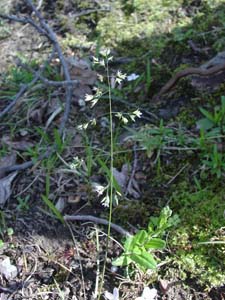 Georgetown University
Georgetown University
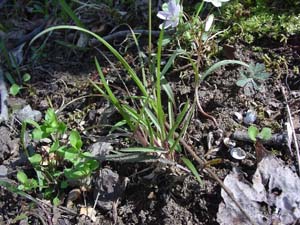 Georgetown University
Georgetown University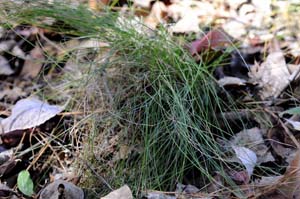 Ed McDowell
Ed McDowellSedges
Sedges, Carex and Scirpus spp.
The flowers of sedges are wind pollinated and do not rely on insects for cross pollination. The larvae of several butterfly species rely on sedges as their food source, as do several species of grasshoppers and leafhoppers. The seeds are an important food source for many upland bird species, including game birds, waterfowl and songbirds. All Carex species are generally cool-season plants. Sedges are not grasses but Graminoids, a term used to describe grass look-alikes. All species of sedges are clump forming.
Yellowfruit Sedge, Yellow-headed Fox Sedge / Carex annectens (Syn. Carex bicknelii)
Life Cycle: Perennial
Characteristics: This is a dense, clumping sedge with a columnar growth habit and narrow, alternate leaves up to 24 inches long. Flowers are terminal spikelets that emerge green, turn yellow, then turn brown as they mature.
Cultural Requirements: Like other sedges, Yellowfruit Sedge prefers moist to wet soils in full sun or partial shade.
Time of Bloom: May to June
Suggested Uses: Use Yellowfruit Sedge in moist areas along streams or ponds that experience seasonal flooding. It also can be grown on upland sites if it is given constant moisture. Its showy spikelets provide ornamental value to moist or aquatic settings.
Georgia Hardiness Zones: All of Georgia
Size: 1 to 3 feet tall and 1 to 2 feet wide
Habitat: Bottomlands, pond margins, roadside ditches and other moist, open sites.
Native To: Maine, south to Florida, west to Texas and north to Nebraska and Minnesota.
Comments: This plant is easy to grow and will naturalize on moist sites.
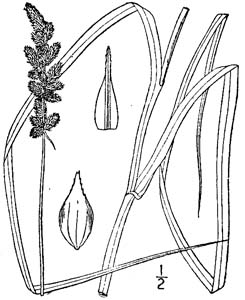 N.L. Britton and A. Brown, NRCS USDA Plants Database
N.L. Britton and A. Brown, NRCS USDA Plants Database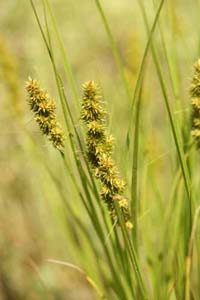 Josh Sulman, Robert W. Freckmann Herbarium
Josh Sulman, Robert W. Freckmann Herbarium
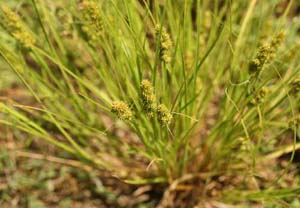 Josh Sulman, Robert W. Freckmann Herbarium
Josh Sulman, Robert W. Freckmann Herbarium
Cherokee Sedge, Bullsedge / Carex cherokeensis
Life Cycle: Perennial
Characteristics: This sedge grows in dense tufts and has narrow, deep green leaves, 12 to 18 inches long. Greenish-white flowers in spring are insignificant, but the drooping wheat-like seed heads are attractive and add interest to the landscape. The plant spreads by rhizomes and seeds.
Cultural Requirements: Cherokee Sedge prefers partial shade and moist soils having a neutral pH. It will adapt to full sun, provided irrigation is available. Cut the plant back to ground level in late summer to make way for new spring growth.
Time of Bloom: March to May
Suggested Uses: Plant Cherokee Sedge in moist open woodland gardens, perennial borders or on pond edges. When given its preferred cultural conditions, it is an attractive, low-maintenance plant.
Georgia Hardiness Zones: All of Georgia
Size: 6 to 18 inches tall and 12 inches wide
Habitat: Moist sandy-loam woodlands, bottomlands, pond edges and roadside ditches.
Native To: Southeastern U.S., from South Carolina to Florida, west to Texas and north to Missouri.
Comments: This plant has no serious insect or disease problems. It is easy to grow and garden worthy. Cherokee Sedge is best established from plugs or bare-rooted plants planted in the fall.
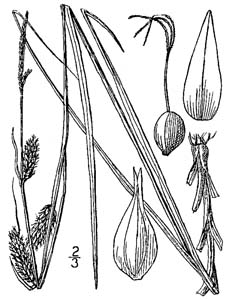 N. L. Britton and A. Brown, USDA PLANTS Database
N. L. Britton and A. Brown, USDA PLANTS Database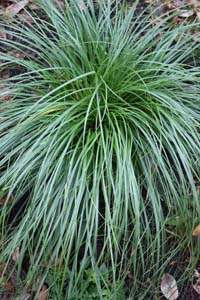 Plant Delights Nursery
Plant Delights Nursery
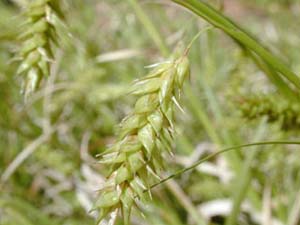 Lady Bird Johnson Wildflower Center
Lady Bird Johnson Wildflower Center
Frank's Sedge / Carex frankii
Life Cycle: Perennial
Characteristics: Leaves are basal, up to 24 inches long and 1/3 inch wide, light green and rough along their edges. The tips of the leaves tend to arch downward. Flowering culms rise 2 1/2 feet and terminate in an inflorescence of three to eight spikelets, 2 inches long and 1/2 inch wide. Flowers are either male or female. Female flowers have long styles and long-awned rough bracts that give them a bristle-like appearance. Male flowers are narrower than female flowers. The plant spreads by rhizomes and seed.
Cultural Requirements: Frank's Sedge prefers full sun to partial shade and moist to wet loamy soil.
Time of Bloom: May to June, bearing fruits from June to July.
Suggested Uses: Use Frank's Sedge in moist areas around water gardens or ponds. It is also used in moist meadows and for wildlife habitat restoration projects.
Georgia Hardiness Zones: All of Georgia
Size: 2 1/2 feet tall and spreading
Habitat: Floodplains, seepages, soggy meadows, streams, ponds and along rivers and ditches.
Native To: New York, south to Georgia, west to Oklahoma and north to Nebraska, Iowa and Michigan.
Comments: This is an attractive plant for moist environments. Frank's Sedge can be grown from seeds or plugs planted in the fall.
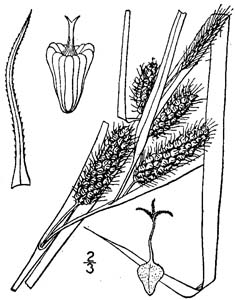 N. L. Britton and A. Brown, USDA PLANTS Database
N. L. Britton and A. Brown, USDA PLANTS Database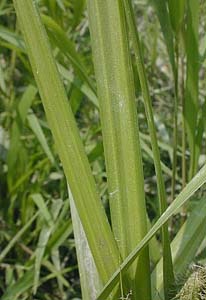 Illinois Wildflowers
Illinois Wildflowers
 Mike Ryon, Oak Ridge National Research Laboratory
Mike Ryon, Oak Ridge National Research Laboratory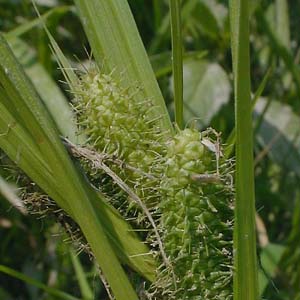 Illinois Wildflowers
Illinois Wildflowers
Southern Waxy Sedge / Carex glaucescens
Life Cycle: Perennial
Characteristics: Southern Waxy Sedge is an erect, clump-forming plant. Leaf sheaths are smooth and pinnately veined. Leaf blades are 16 to 24 inches long and 1/4 to 3/8 inch wide. Flowering culms bear five to seven grayish-blue spikelets, 2 to 4 inches long, that hang downward on stalks. Twisted, reddish-brown floral remnants persist on the surface of the spikelets.
Cultural Requirements: Southern Waxy Sedge prefers full sun and moist to wet soil. However, it will adapt to dry sites. It also adapts to a wide variety of soil types. Cut back plants in the late fall or winter to make way for new spring growth.
Time of Bloom: April
Suggested Uses: Use Southern Waxy Sedge along pond margins or in moist meadows or floodplains.
Georgia Hardiness Zones: All of Georgia
Size: 2 to 4 feet tall and 2 feet wide
Habitat: Bogs, pond margins, wet pine savannas and seepage areas.
Native To: Maryland, south to Florida, west to Texas and North to Arkansas.
Comments: The species name, glaucescens, stems from the Greek prefix “glauc,” which means gray or blue-gray, referring to the blue-green color of the seed heads.
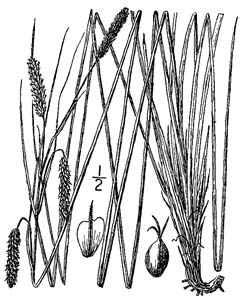 N. L. Britton and A. Brown, USDA PLANTS Database
N. L. Britton and A. Brown, USDA PLANTS Database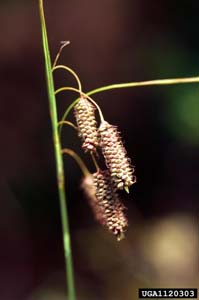 James H. Miller, USDA Forest Service, Bugwood.org
James H. Miller, USDA Forest Service, Bugwood.org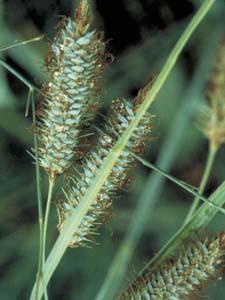 David Dunatchick - Lady Bird Johnson Wildflower Center, Austin, TX
David Dunatchick - Lady Bird Johnson Wildflower Center, Austin, TX Dwight K. Lauer, Auburn University, Bugwood.org
Dwight K. Lauer, Auburn University, Bugwood.org
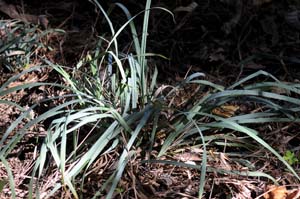 Ed McDowell
Ed McDowell
Limestone Meadow Sedge / Carex granularis
Life Cycle: Perennial
Characteristics: Leaves and culms are bluish-green. Leaves are 12 inches long and 1/3 inch wide. In May, several flowering culms rise above the foliage bearing five alternate leaves. They produce one to two axillary spikelets of pistillate (female) flowers, one to two terminal spikelets of pistillate flowers, and a single terminal spikelet of staminate (male) flowers. The pistillate flowers develop into three-angled achenes. The plant spreads by seed and rhizomes.
Cultural Requirements: Limestone Meadow Sage prefers moist, well-drained soil and partial shade to full shade. It likes alkaline soil with a pH between 6.5 and 7.5. Cut back the plant in winter to make way for new spring growth.
Time of Bloom: May
Suggested Uses: Limestone Meadow Sedge can be used as a groundcover in moist sites and is an excellent plant for rain gardens, bio-retention basins and ditches.
Georgia Hardiness Zones: All of Georgia
Size: 6 inches tall and 12 inches wide
Habitat: Moist woodlands, swamps, bottomlands, moist prairies, seeps, limestone cliffs and abandoned fields.
Native To: Maine, south to Florida, west to Texas and north to North Dakota.
Comments: Limestone Meadow Sedge can be distinguished from other Carex species by the grainy appearance of the pistillate spikelets and the presence of both axillary and terminal pistillate spikelets. The plant is easy to establish from plugs or bare-rooted plants planted in the fall.
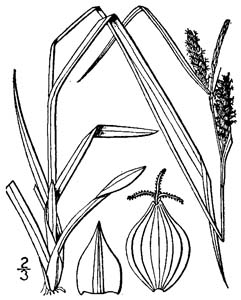 N. L. Britton and A. Brown, USDA PLANTS Database
N. L. Britton and A. Brown, USDA PLANTS Database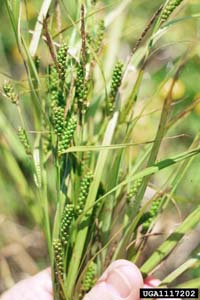 Charles T. Bryson, USDA, Agricultural Research Service, Bugwood.org
Charles T. Bryson, USDA, Agricultural Research Service, Bugwood.org
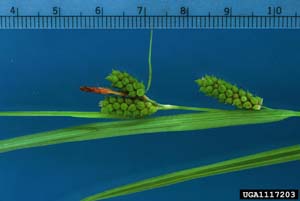 Charles T. Bryson, USDA, Agricultural Research Service, Bugwood.org
Charles T. Bryson, USDA, Agricultural Research Service, Bugwood.org
Shallow Sedge, Lurid Sedge / Carex lurida
Life Cycle: Perennial
Characteristics: Shallow Sedge forms a tuft of basal leaves from which rise one or more culms up to 2½ feet long. The culms are triangular and rough along their edges. One to three alternate leaves, 12 inches long and ¼ inch wide, are borne on the lower half of each culm. In May, a terminal inflorescence bears one to four pistillate (female) spikelets and a single staminate (male) spikelet. The pistillate spikelets are yellow-green and bunched together under the staminate spikelet. The staminate spikelet resembles a corn cob as it matures, while the pistillate (female) spikelets resemble small elongated footballs with spikes. The plant spreads by seed.
Cultural Requirements: Shallow Sedge prefers full sun to partial shade and moist to wet soil.
Time of Bloom: May
Suggested Uses: Use Shallow Sedge in moist areas around water gardens, in wet meadows, bottomlands or adjacent to bodies of water.
Georgia Hardiness Zones: All of Georgia
Size: 1 to 3 feet tall and 1 to 2 feet wide
Habitat: Prairie swales, sedge meadows, bogs, swamps, edges of marshes, borders of ponds and streams, and ditches.
Native To: The eastern half of the U.S., from Maine to Florida, west to Texas and north to Minnesota.
Comments: Shallow Sedge can be established from plugs, seeds or bare-rooted plants planted in the fall.
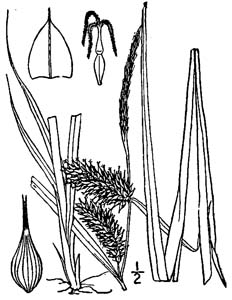 N. L. Britton and A. Brown, USDA PLANTS Database
N. L. Britton and A. Brown, USDA PLANTS Database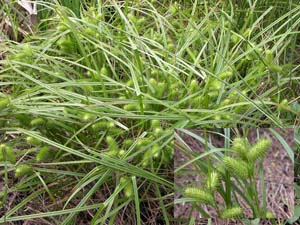 S. L. Winterton, Aquarium and Pond Plants of the World
S. L. Winterton, Aquarium and Pond Plants of the World
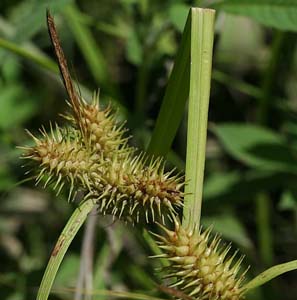 Illinois Wildflowers
Illinois Wildflowers
Pennsylvania Sedge / Carex pennsylvanica
Life Cycle: Perennial
Characteristics: Leafy culms, 6 to 18 inches long, have a triangular shape and bear several alternate leaves throughout their length. Leaves are arching, 1/8 inch across and 4 to 12 inches long. In spring, flowering culms bear a narrow terminal staminate (male) spikelet, 1/2 to 1 inch long, and two to three pistillate (female) spikelets. Each pistillate floret within a spikelet has three white styles and is subtended by a purple leafy or scale-like bract. Fruit are three-sided achenes. The plant spreads by stolons that creep along the soil surface and form new plantlets at their nodes.
Cultural Requirements: Pennsylvania Sedge prefers partial shade to full shade and dry, well-drained soil.
Time of Bloom: May to June
Suggested Uses: The fine-textured foliage and creeping growth habit make Pennsylvania Sedge a good ground cover for erosion-prone sites and densely shaded areas with dry soil. It should be tried as a turfgrass alternative in dry shady areas under trees where most turfgrasses refuse to grow. It is also useful in wildlife habitats.
Georgia Hardiness Zones: 6, 7, 8a
Size: 6 to 12 inches tall and spreading
Habitat: Dry open woodlands, thinly wooded bluffs, wooded slopes, sandy savannas and rocky openings in wooded areas.
Native To: Maine, south to Georgia, west to Mississippi and north to Arkansas, Missouri, Iowa, South Dakota and North Dakota.
Comments: This plant provides seasonal cover and food for small songbirds, insects and small mammals. It is deer tolerant. It is difficult to establish from seed but easy to establish from plugs or bare-rooted plants planted in the fall.
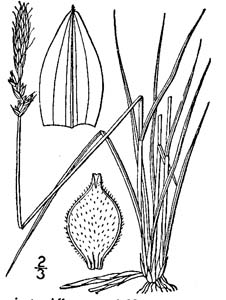 N. L. Britton and A. Brown, USDA PLANTS Database
N. L. Britton and A. Brown, USDA PLANTS Database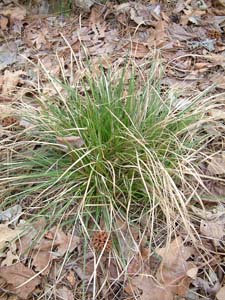 Lady Bird Johnson Wildflower Center
Lady Bird Johnson Wildflower Center
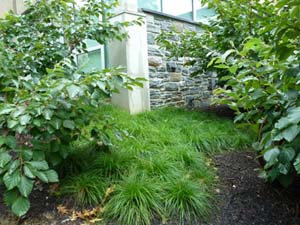 Scott Arboretum
Scott Arboretum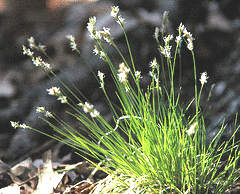 Fern Hill Landscapes
Fern Hill Landscapes
Seersucker Sedge, Plantainleaf Sedge / Carex plantaginea
Life Cycle: Perennial
Characteristics: Leaves are borne in a basal rosette. They are broad, up to 1¼ inches wide and 12 inches long. Basal leaves are pleated, giving it a seersucker appearance. The bases of the leaves have a purplish tinge. Leaves along the culms are short, reddish-purple tubular bracts. In spring, green flowering culms rise above the basal leaves, each bearing two to four erect pistillate (female) spikelets and a single terminal staminate (male) spikelet. The spikelets are widely spaced along the culm. Each pistillate spikelet is ½ to 1½ inches long, cylindrical in shape and tinted light purple at the tip. The lowest pistillate spikelet is borne on a small peduncle (stalk) while the remaining ones are sessile. The staminate spikelet is ¾ inch long and reddish purple. Fruit are three-sided achenes. The plant spreads by seeds and rhizomes.
Cultural Requirements: Seersucker Sedge prefers partial shade to full shade and moist acidic soil high in organic matter. It is susceptible to a leaf spot disease and aphids. Propagate this plant by dividing the clumps in early spring.
Time of Bloom: March to May
Suggested Uses: Seersucker Sedge, with its broad, showy leaves, provides a nice texture in moist woodlands and shady habitats.
Georgia Hardiness Zones: 6, 7, 8a
Size: 1 to 2 feet tall with an equal width
Habitat: Seersucker Sedge grows in deciduous mountainous woodlands, wooded slopes and ravines. It is a distinctive member of fertile forest floors and can be found growing adjacent to spring-flowering wildflowers.
Native To: Maine, south to Georgia and Alabama, and north to Iowa, Minnesota and Wisconsin.
Comments: This is a showy plant in the right habitat.
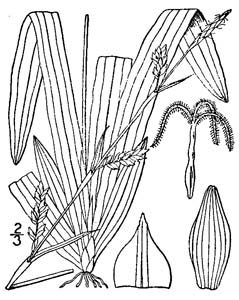 N. L. Britton and A. Brown, USDA PLANTS Database
N. L. Britton and A. Brown, USDA PLANTS Database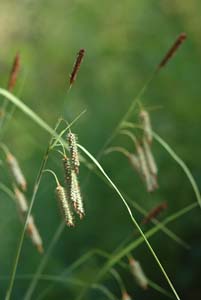 Ed McDowell
Ed McDowell
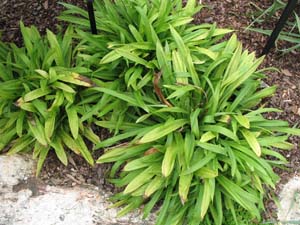 Online Plant Guide
Online Plant Guide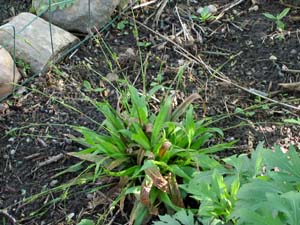 U.S. Forest Service
U.S. Forest Service
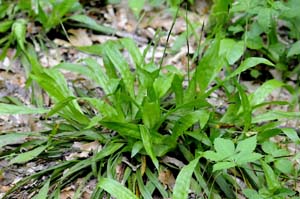 Ed McDowell
Ed McDowell
Tussock Sedge, Upright Sedge / Carex stricta
Life Cycle: Perennial
Characteristics: Smooth, narrow yellowish-green leaves, 3/8 inch in diameter, grow in dense clumps. Old leaves wither, die, turn brown and accumulate around the base of the plant. In late spring, flowering culms rise above the foliage and bear reddish-brown spikelets. The plant spreads by rhizomes to form large colonies.
Cultural Requirements: Tussock Sedge prefers full sun to partial shade and moist to wet soil.
Time of Bloom: May to June
Suggested Uses: Tussock Sedge is used in moist meadows and moist open woodlands. It also is used for wetland reclamation and wildlife habitats along streams, pond margins and areas that get seasonal flooding. It provides a nice accent in cultivated landscapes if it can be kept moist.
Georgia Hardiness Zones: All of Georgia
Size: 1 to 3 feet tall and 2 feet wide
Habitat: This is a wetland species native to wet swales, marshes, bogs, wet meadows and creek margins.
Native To: The eastern half of the U.S., from Maine to Georgia, west to Texas and north to North Dakota.
Comments: This plant grows in mounds called tussocks. The tussocks trap water between them, helping other aquatic plants get established. The plant provides cover for breeding frogs, toads, salamanders and insects, and nesting materials for a variety of birds, including ducks, small herons, sparrows and geese. A number of birds and small mammals feed on the seeds.
 N. L. Britton and A. Brown, USDA PLANTS Database
N. L. Britton and A. Brown, USDA PLANTS Database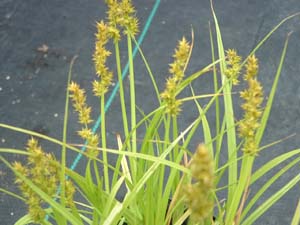 Morning Sky Greenery
Morning Sky Greenery
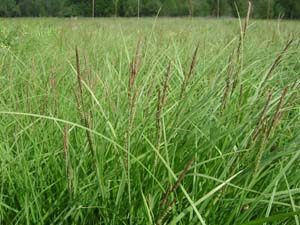 Prairie Moon Nursery
Prairie Moon Nursery
Wool Grass, Cottongrass Bulrush / Scirpus cyperinus
Life Cycle: Perennial
Characteristics: Low-growing vegetative shoots bear leaves ½ inch wide and up to 2 feet long. In summer, flowering culms rise above the foliage and terminate in an inflorescence 4 to 6 inches long. It consists of many branchlets that terminate in small clusters of spikelets. The spikelets become reddish brown and wooly at maturity. They persist into the fall.
Cultural Requirements: Wool Grass grows in full sun, wet sites and standing water.
Time of Bloom: June to September
Suggested Uses: Wool Grass is a wetland plant for wet meadows or wildlife habitats in aquatic areas.
Georgia Hardiness Zones: All of Georgia
Size: 3 to 6 feet tall and 1 to 2 feet wide
Habitat: Wet meadows and swamps. It will grow in standing water.
Native To: Most of the continental U.S., except Arizona, New Mexico, Nevada, Utah, Colorado, Kansas, Nebraska and North Dakota.
Comments: Birds eat the seeds of this plant, and the foliage provides nesting materials. Muskrats and geese eat the roots. It can be established from plugs planted in the fall.
 N. L. Britton and A. Brown, USDA PLANTS Database
N. L. Britton and A. Brown, USDA PLANTS Database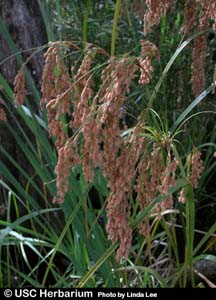 University of South Carolina Herbarium
University of South Carolina Herbarium
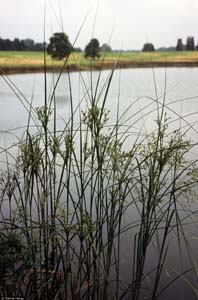 Elaine Haug, USDA-NRCS PLANTS Database
Elaine Haug, USDA-NRCS PLANTS Database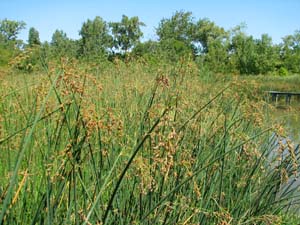 Ohio State University
Ohio State UniversityGlossary
achene: A small, dry thin-walled fruit that does not split open when ripe.
annual: A plant that completes its life cycle in one year or less.
auricle: A small, ear-shaped appendage at the base of the leaf blade.
awn: A bristle-like appendage on a floret or seed, often the extension of veins in glumes or lemmas.
axil: The angle between a leaf and its stem or branch or the angle between a branch or pedicel and its axis.
axillary: Growing in the axil.
bald: A barren area of land.
bare-rooted plants: Plants that have been dug up and transplanted from one location to another.
blade: The upper expanded part of a grass leaf.
bract: A reduced leaf or leaf-like structure at the base of a flower or inflorescence.
bristle: A reduced or modified leaf.
collar: The outside area of a grass leaf where blade and sheath join.
compressed: Flattened laterally.
cool-season grass: Grasses that make their active growth in winter, early spring or late fall.
culm: A hollow or pithy stalk or stem.
cultivars: A unique cultivated variety.
dead-heading: Removing spent blossoms after flowering.
dissected: Cut or divided into parts.
floret: An individual flower within a dense cluster of flowers.
forb: A herbaceous plant, other than a grass, usually growing in a field or meadow.
glabrous: Smooth, hairless.
glaucous: Covered with a whitish or bluish waxy film.
glumes: A pair of bracts at the base of a grass spikelet.
husk: The tough outer covering found on some seeds and fruit.
inflorescence: The seed head or flowering portion of a plant.
internode: The part of a stem between two nodes or joints.
keel: The sharp fold at the back of a compressed sheath, blade, glume or lemma.
lance-shaped: Several times longer than broad; broadest below the middle and tapered toward the top.
lemma: The bract of a spikelet above the pair of glumes.
ligule: In grasses, a thin, membranous, hairy or ridge-like appendage on the side of the leaf where the blade and sheath join.
margin: The edge, such as the edge of a leaf blade.
mesic: Moderately moist.
midrib: The central vein of a leaf.
node: The joint of a grass stem where leaves and branches originate.
palea: The inner bract of a grass floret.
panicle: A seed head with a main axis and subdivided branches. It may be open or compact and spike-like. Most panicles mature from the bottom upward.
pedicel: The stalk that holds a single flower on an inflorescence.
peduncle: The stalk that holds the inflorescence.
perennial: A plant that produces above-ground parts from the same root system for more than one growing season.
petiole: The stalk of a leaf blade.
pinnate: Having leaflets or leaf veins in a feather-like arrangement on each side of a common axis.
pistillate: Having only female flower parts.
plugs: Small plants with established roots.
pubescence: A covering of short hairs.
raceme: A branched seed head in which the spikelets are borne on short stalks on a rachis.
rachis: The axis of a spike or raceme.
rhizomatous: Spreading via rhizomes (underground stems).
rhizome: An underground stem with nodes, buds and scale-like leaves.
seed: The grain or ripened ovule of a plant.
seed stalk: The stem on which a grass seed head develops.
sessile: Without a stalk or lacking a pedicel.
spathe: A bract or pair of bracts that often encloses an inflorescence.
spike: An unbranched seed head in which the spikelets are sessile on a rachis.
spikelet: The basic unit of a grass seed head consisting of one or more florets and a pair of glumes.
staminate: Having only male flower parts.
stolon: A horizontal, above-ground stem or runner that roots along its nodes.
style: Pollen tube connecting the stigma to the ovary. warm-season grasses: Grasses that make their active growth during the spring and summer.
warm-season grasses: Grasses that make their active growth during the spring and summer.
References
Books
Cullina, William. 2008. Native Ferns, Mosses and Grasses. Houghton Mifflin Publishing Company, ISBN: 0-618-53118-1.
Darke, Rick. 1999. The Color Encyclopedia of Ornamental Grasses. Timber Press, ISBN: 0-88192-464-4.
Greenlee, John and Derek Fell. 1992. The Encyclopedia of Ornamental Grasses. Michael Friedman Publishing Company. ISBN:0-87596-100-2.
Greenlee, John. 2009. The American Meadow Garden, Creating a Natural Alternative to the Traditional Lawn. Timber Press ISBN 978-0-88192.
Horn, Dennis, Tavia Cathcart, Thomas E. Hemmerly and David Duhl. 2005. Wildflowers of Tennessee, the Ohio Valley and the Southern Appalachians. Lone Pine Publishing Co., ISBN: 1-55105-428-5.
Leithead, Horace L., Lewis L. Yarlett and Thomas N. Shiflet. 1971. 100 Native Forage Grasses in 11 Southern States. Agricultural Handbook no. 389. USDA Soil Conservation Service. Available from the South Carolina Native Plant Society, http://scnps.org/.
Reinhardt, Thomas A., Martina Reinhardt, Mark Moskowitz and Derek Fell. 1989. Ornamental Grass Gardening. Michael Friedman Publishing Company, ISBN: 0-89586-745-1.
Zimmerman, Catherine. 2010. Urban & Suburban Meadows: Bringing Meadowscaping to Big and Small Spaces. Matrix Media Press ISBN 978-0-88192-871-6.
Websites and Online Publications
A Landowner's Guide to Native Warm-season Grasses in the Mid-south. University of Tennessee Extension publication 1746.
American Beauties Native Plants, http://www.abnativeplants.com/
Annie's Annuals and Perennials, http://www.anniesannuals.com/plt_lst/our-plants.php
Backyard Gardener, http://www.backyardgardener.com/Plant-Index/
Blue Planet Biome, http://www.blueplanetbiomes.org/plant_index.htm
Buffalo Brand Seed Co., http://www.buffalobrandseed.com/
Center for Invasive Species and Ecosystem Health, University of Georgia, http://www.bugwood.org/
Dave's Garden, https://davesgarden.com/guides/pf/
Dropseed Native Plant Nursery, http://www.dropseednursery.com
Dufault, Robert J., Mary Jackson, and Stephen K. Salvo. Sweetgrass: History, Basketry, and Constraints to Industry Growth, Purdue University Horticulture
Fine Gardening Magazine, http://www.finegardening.com/plantguide/
Fine Gardening, http://www.finegardening.com/plantguide/
FloriData, http://www.floridata.com/lists/contents.cfm
Forrest Keeling Nursery,https://www.fknursery.com/
Garden Guides, http://www.gardenguides.com/taxonomy/
Grasses of Iowa, https://www.eeob.iastate.edu/research/IowaGrasses/
Grasses, Sedges and Rushes of Martin and Palm Beach Counties, Florida Grasses, http://www.floridagrasses.org/
Horticulture Magazine, http://www.hortmag.com/plants
Illinois Wildflowers, http://www.illinoiswildflowers.info/
Island Connections News, Sweet Grass Article, http://islandconnectionnews.com/?p=1864
Kansas Wildflowers and Grasses, http://www.kswildflower.org/
Kemper Center for Home Gardening, Missouri Botanical Garden, http://www.mobot.org/gardeninghelp/plantfinder/Alpha.asp
Ladybird Johnson Wildlife Center, http://www.wildflower.org/explore/
Maine Department of Conservation Natural Areas Program, Rare and Endangered Plants, http://www.maine.gov/doc/nrimc/mnap/features/rareplant.htm
Native Wildflowers and Prairie Grasses, Ion Exchange, Inc., http://ionxchange.com/
Natives for Your Neighborhood, a program of the Institute for Regional Conservation, http://regionalconservation.org/beta/nfyn/plantlist.asp
NC State University Plant Fact Sheets
North Creek Nurseries, http://www.northcreeknurseries.com/index.cfm
Plant Delights Nursery, http://www.plantdelights.com/
The Plantsmen Nursery, http://www.plantsmen.com/
Prairie Moon Nursery, http://www.prairiemoon.com
Rock Spring Farm, http://www.rockspringfarm.com
The Bugwood Network, The University of Georgia Center for Invasive Species and Ecosystem Health, http://www.bugwood.org/
Tropical Forages, https://www.tropicalforages.info/
U.S. Geological Survey, Northern Prairie Wildlife Research Center
University of Florida Center for Aquatic and Invasive Plants, http://plants.ifas.ufl.edu/
University of Michigan Herbarium, http://lsa.umich.edu/herbarium
Virginia Tech Weed Identification Guide, http://www.ppws.vt.edu/scott/
Wikipedia, the Free Encyclopedia, http://en.wikipedia.org/wiki/Wiki
Wild Plants of Friendswood Texas, http://www.friendswoodplants.blogspot.com/
Woodlanders Nursery, http://www.woodlanders.net/index.cfm
Guide to Selecting Native Grasses and Sedges
Download the native grasses and sedges selection guide chart, detailing the plants' bloom time, light levels, moisture needs, and more.
Acknowledgments
Appreciation is expressed to the following individuals, organizations, businesses or websites for providing photos or line drawings for this publication:
A. Brown
A.S. Hitchcock
Aquarium and Pond Plants of the World
Arasapha Native Plant Garden
B.S. Walters
Bob Harms
Bobby Hattaway
Bugwood.org
Charles T. Bryson
Christine Bingham
Dan Tenagli
David Dunatchick
Digital Atlas of Virginia Flora
Dropseed Native Plant Nursery
Elaine Haug
Emmet J. Judziewicz
Fern Hill Landscapes
FloridaGrasses.org
Forest and Kim Starr
Gary P. Fleming
Georgetown University
Hugh and Carol Nourse
Illinois Wildflowers
J.K Marlow
James H. Miller
Jennifer Anderson
Jeff McMillian
John D. Byrd
Josh Sulman
Karen Rawlins
Keep the Midlands Beautiful
Kentucky Native Plant Society
Lady Bird Johnson Wildflower Center
Larry Allain
Matthew C. Perry
Mike Ryon
Missouri Botanical Garden
Morning Sky Greenery
N.L. Britton
Nancy Staunton
National Drought Mitigation Center
Norman Melvin
Oak Ridge National Research Laboratory
Ohio State University
Paul Drobot
Pitt State Herbarium
Plant Delights Nursery
Richard Old
Richard L. Ware
Robert W. Freckmann Herbarium
Robert H. Mohlenbrock
S.L. Winterton
Scott Arboretum
Shirley Denton
Ted Bodner
Tim Murphy
U.S. Geological Survey
University of South Carolina Herbarium
USDA Plants Database
USDA, NRCS
W.J. Hayden
Acknowledgment is also made to the following individuals for their thorough and expert review of this publication: Bill Stinger, Department of Agronomy, Clemson University; Mike Owsley, Manager of the USDA, NRCS Jimmy Carter Plant Materials Center, Americus, Ga.; Gary Kauffman, U.S. Forest Service Southern Research Station, Ashville, N.C.; Walter Bland, Rock Spring Farm, Atlanta, Ga.; and Sharlys Crisafulli, Georgia Master Gardener and retired librarian.
Finally, the senior author expresses his heartfelt appreciation to Elaine Nash, Ed McDowell and Brenda Beckham for their expertise, patience and perseverance in developing this four-part publication series on Native Plants for Georgia.
Status and Revision History
Published on Apr 16, 2013
Published with Full Review on Feb 01, 2016
Published with Full Review on Aug 31, 2017
Published with Full Review on Apr 01, 2021
Published with Full Review on Aug 29, 2024


























































